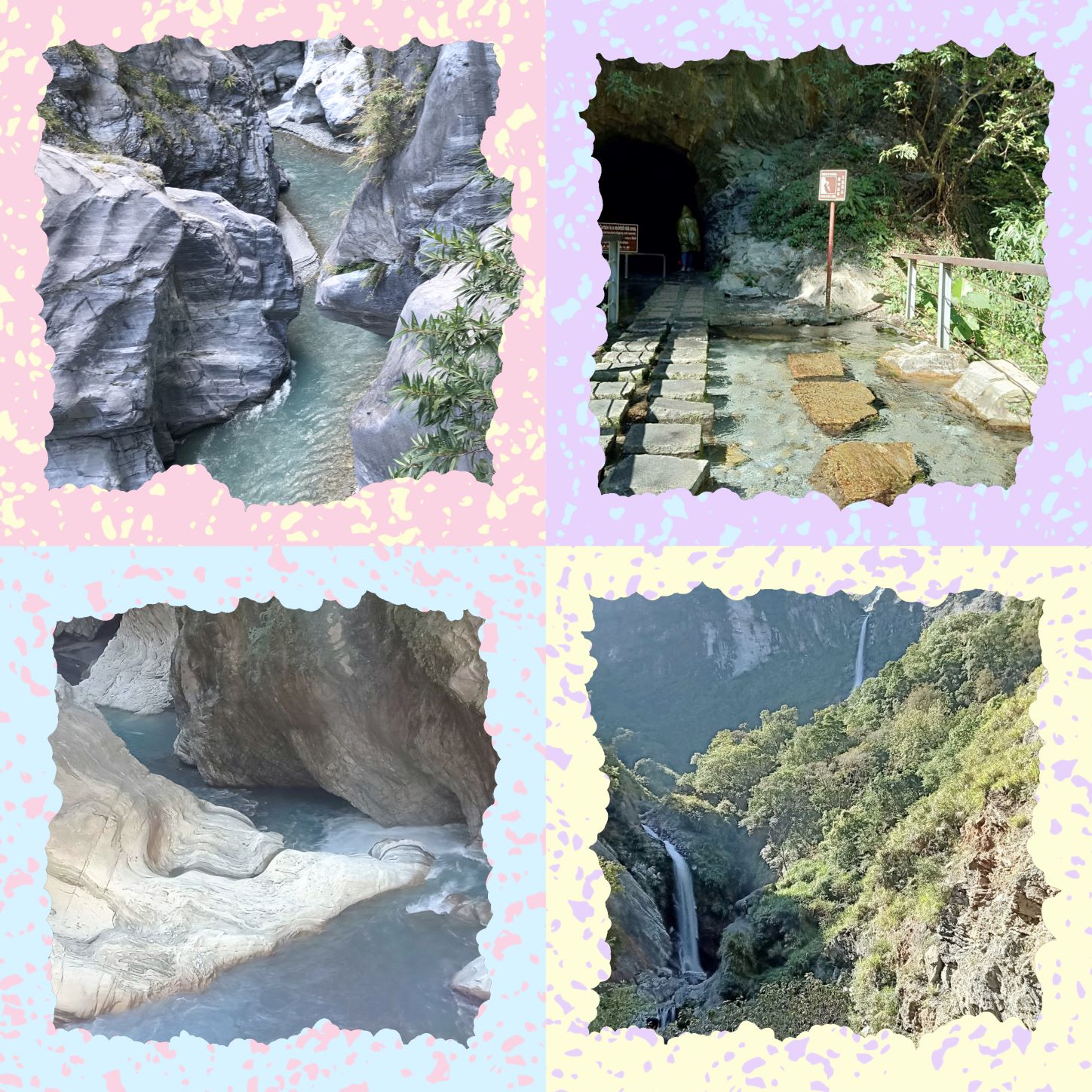10 DAYS
Enjoy 10 days tour to visit hot spots around Taiwan
Greetings for arrival
Transfer to Taipei for 1 day tour
Taipei 101 / Chiang Kai-Shek Memorial Hall / Longshan Temple
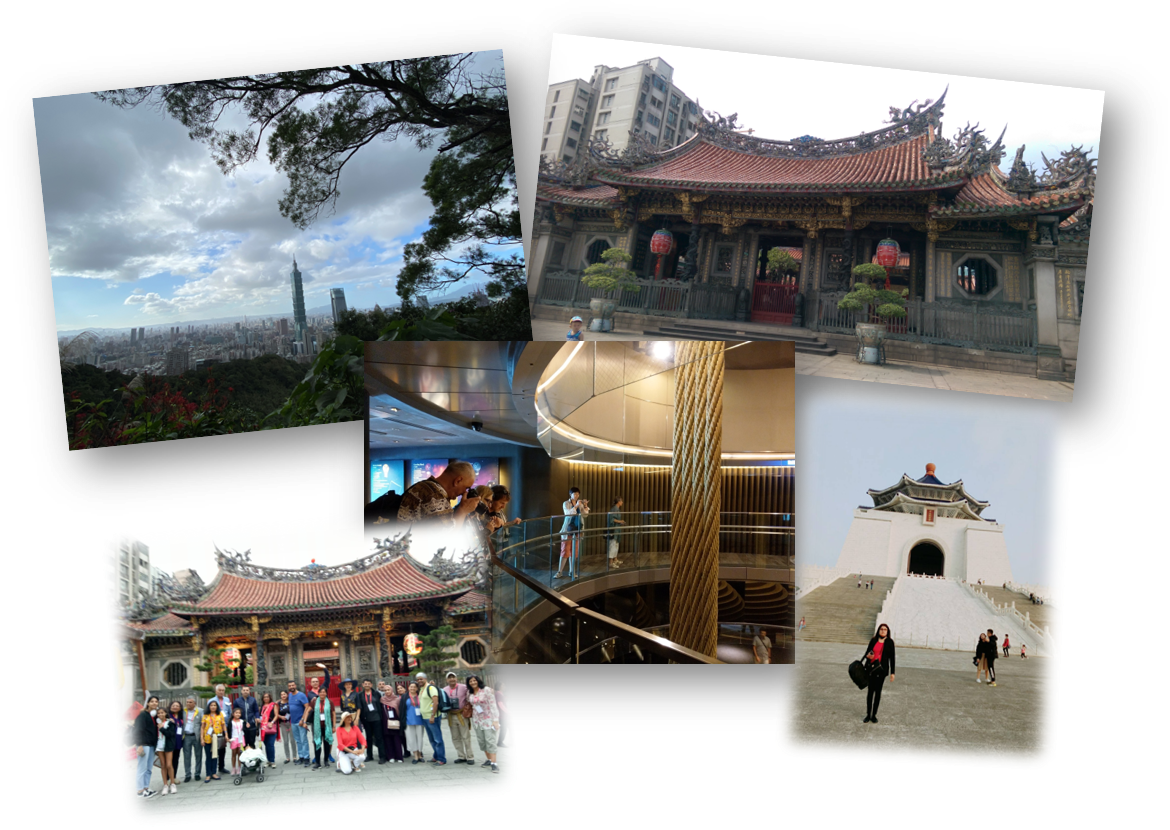
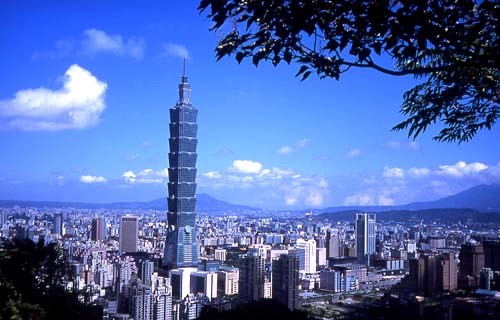
Taipei 101
The Taipei 101 is designed to resemble a growing bamboo stalk, a symbol of everlasting strength in Chinese culture.
Taiwan doesn't have many ostentatious records in its history, but Taipei 101, designed by local architect C.Y. Lee, brings one.
It was the first skyscraper to go past the half-kilometer mark and it sat at the pinnacle of the skyscraper world from 2004 to 2009.
Taipei 101 can also claim to have the world's fastest passenger elevator.
At an ear-popping 1,010 meters per minute, it takes 37 seconds to catapult passengers from the fifth floor to the highest point in Taiwan.
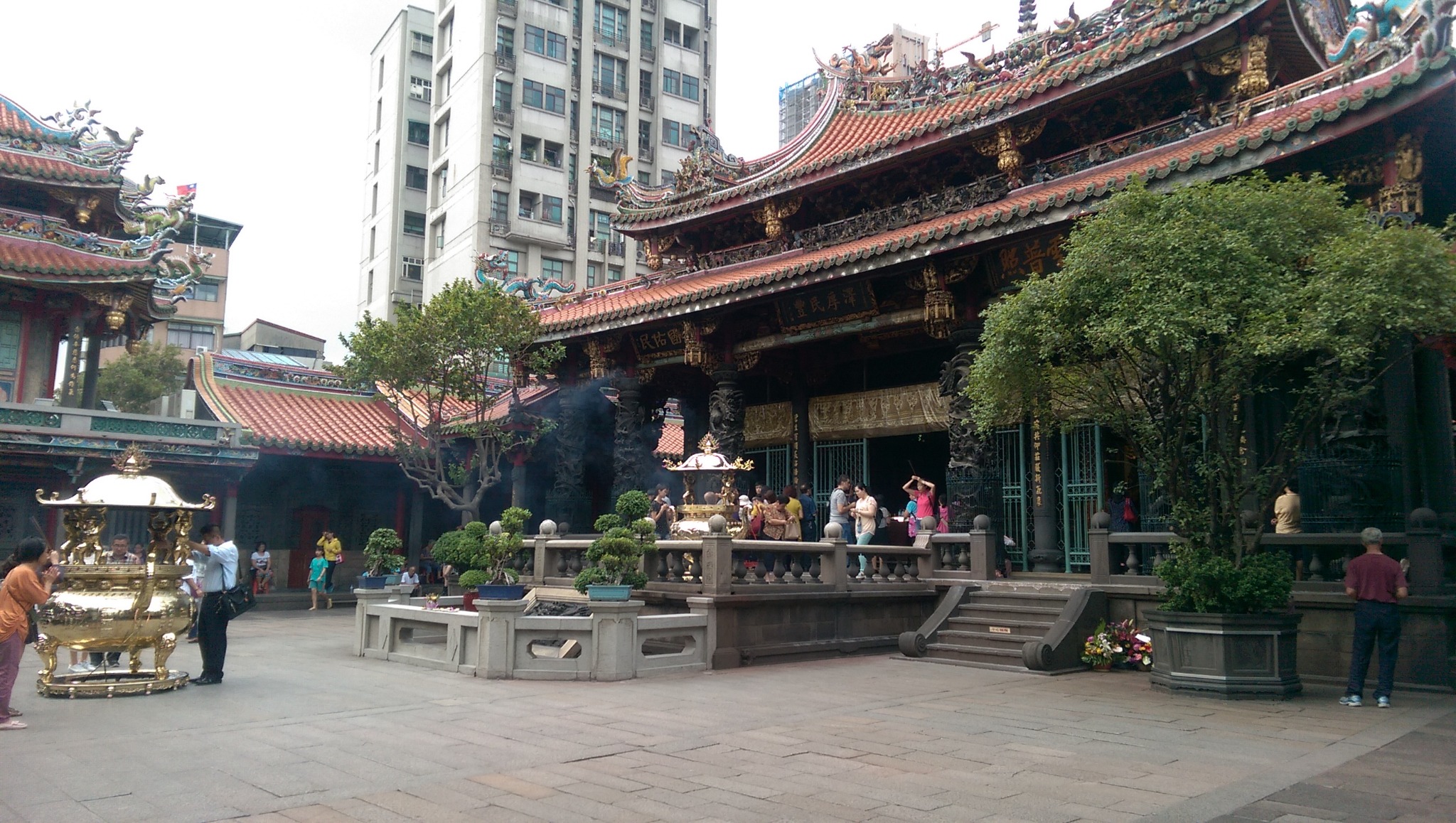
Longshan Temple
The Long Shan Temple originated its name from the ancient Lungshan Temple established in Chin-chiang county of Fukien province in the seventh century. Immigrants from the three counties Chin-chiang, Nan-an and Hui-an of Fukien came to Manka in the beginning of the eighteenth century.
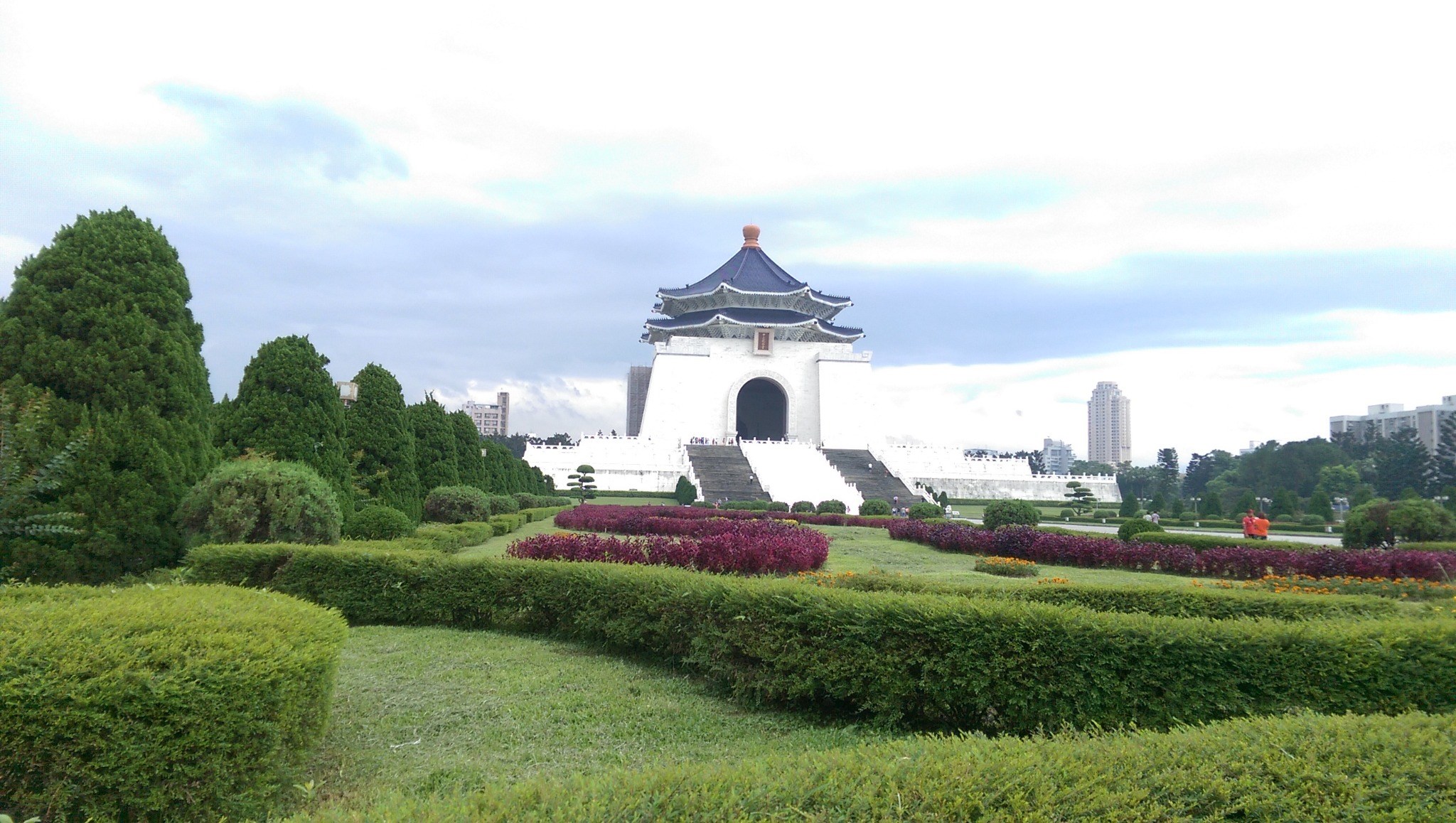
Chiang Kai-Shek Memorial Hall
The most prominent historical landmark in Taiwan, the CKS Memorial Hall was erected in honor and memory of Generalissimo Chiang Kai-shek, the former President of the Republic of China, and was opened in 1980 as part of a national park and gathering area.
The name of the square is officially Liberty Square (自由廣場), as seen above the front gate, however the name change was politically motivated and most people in practice still refer to the entire complex as CKS Memorial Hall.
The octagon-shaped white building rises 76 meters and is covered with blue tiles and red accents, echoing the flag of the Republic of China. The eight sides represent the Chinese cultural symbolism of the number eight which is traditionally associated with fortune and wealth. The two sets of 89 steps represent Chiang's age of death and lead up to main hall housing a large bronze statue of Chiang protected by military personnel which change hourly.
The characters behind Chiang's statue read "Ethics", "Democracy", and "Science", and the inscriptions on the side read "The purpose of life is to improve the general life of humanity" and "The meaning of life is to create and sustain subsequent lives in the universe".
Below the hall is a museum documenting Chiang's life and career, as well as exhibits about Taiwan's history, pan-Chinese culture and history, and the ROC's development after moving to Taiwan.
-
-
v
v
-
4-star or 5-star hotel in Taipei
Breakfast at Hotel
Check out and transfer for 1 day tour
Morning:
National Palace Museum
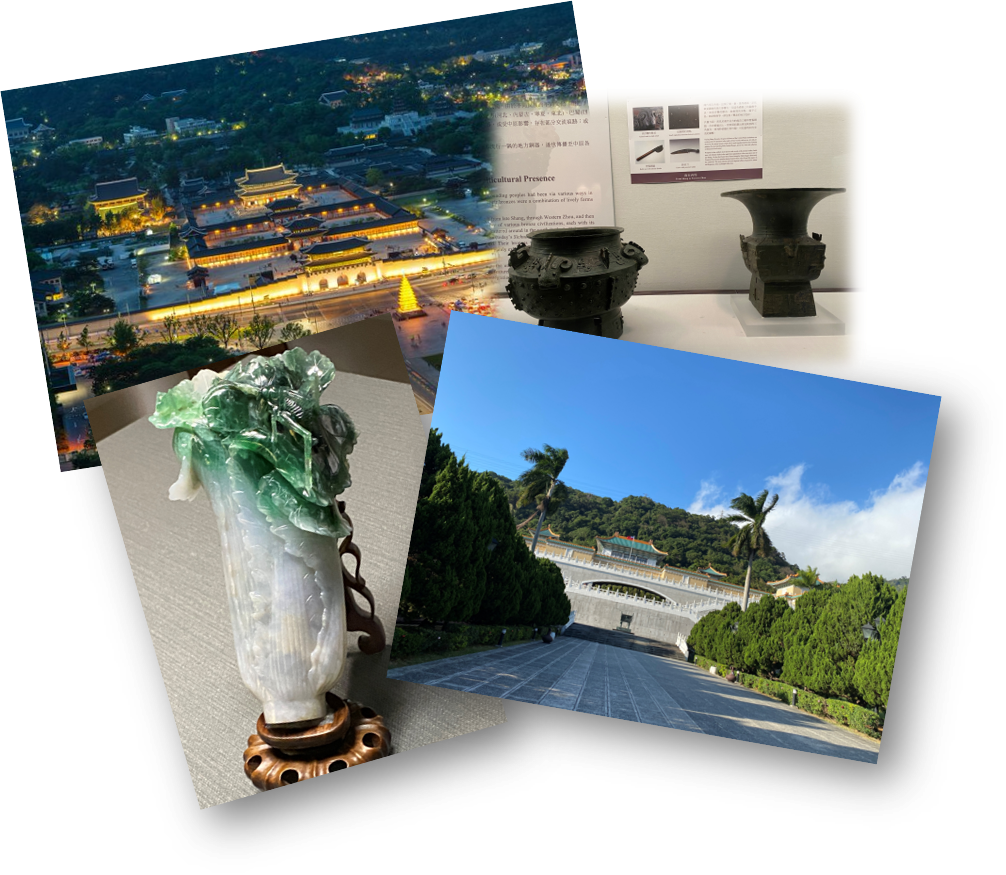
Afternoon: traveling to Hualien
Cingshui Cliff / National Taroko Park
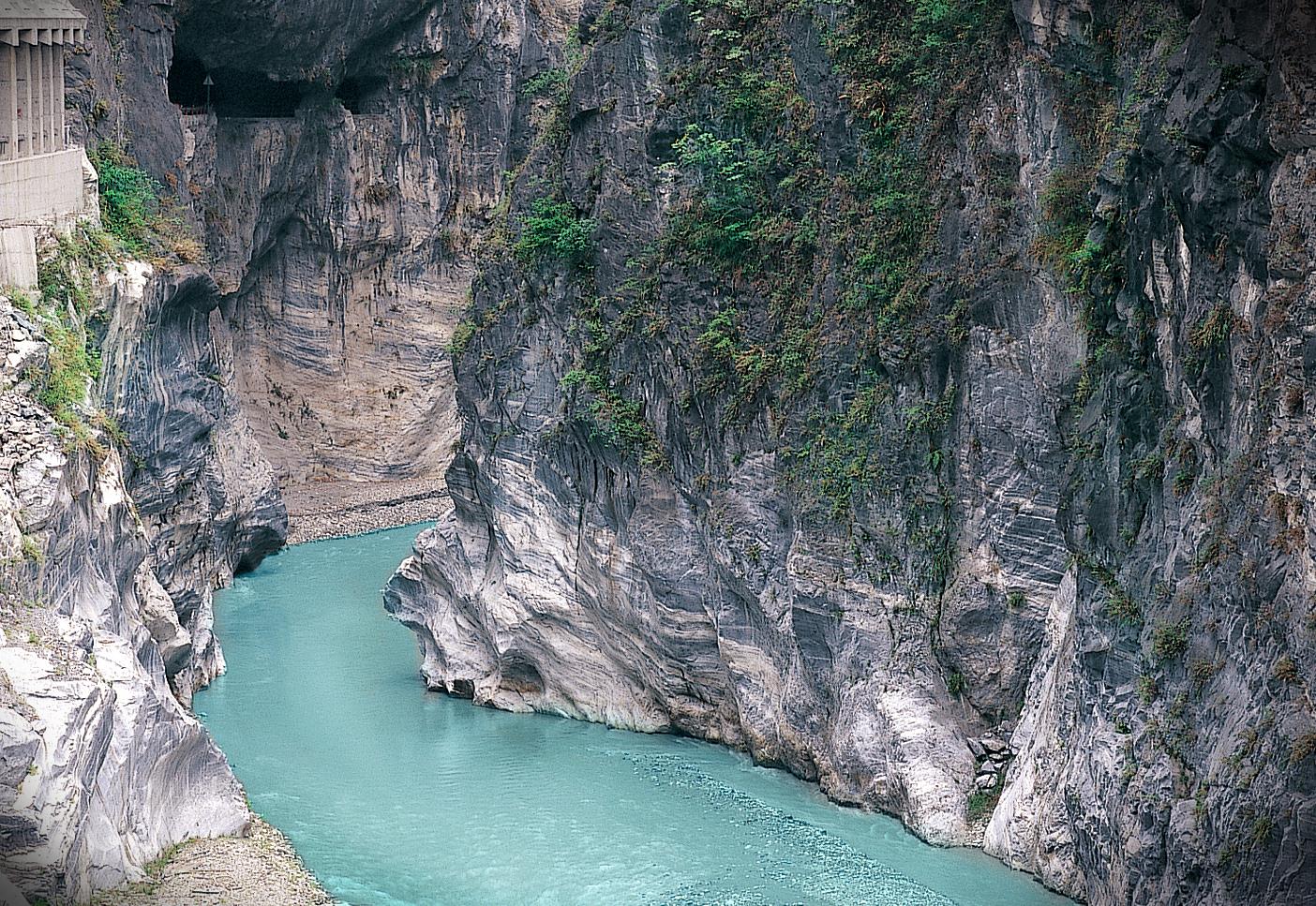
National Palace Museum
World's 20 most-popular museums - National Palace Museum Taiwan
The National Palace Museum displays the world's greatest and rarest collection of traditional Chinese art crafts and historical documents. These priceless treasures include ancient Chinese paintings, archeological remains of bronze weapons, ceramics, jade, sculptures, books and other antiques. With more than 700,000 items on display, many of which once belong in Beijing's Forbidden City. The National Palace Museum truly reflects the rich cultural heritage of Chinese civilization and ancient Chinese culture. The National Palace Museum was established in 1925 and was expanded and remodeled in 1965.
National Taroko Park
World's Top 10 must-see sights - Taroko Gorge
The Taroko Gorge is a spectacular 19-kilometer long canyon in Taiwan's east coast a short drive from Hualien. The climate is usually cool and humid, but again perfect for any of the trekking options at any of the long or short trails available, biking or whitewater rafting.
It's just over 60 kilometers from the coast, yet it is home to some of the highest peaks in Taiwan at over 3,400 meters.
It can be easily visited by bus, car or scooter and has enough treks to keep you busy for several days, but most people usually only visit it on one.

-
v
v
v
-
Taroko Village Hotel or Silks Place Taroko
Breakfast at Hotel
Morning: Baiyang Trail/Baiyang Waterfall
Afternoon: Tunnel of Nine Turns / Swallow Grotto / Shakadang Tail
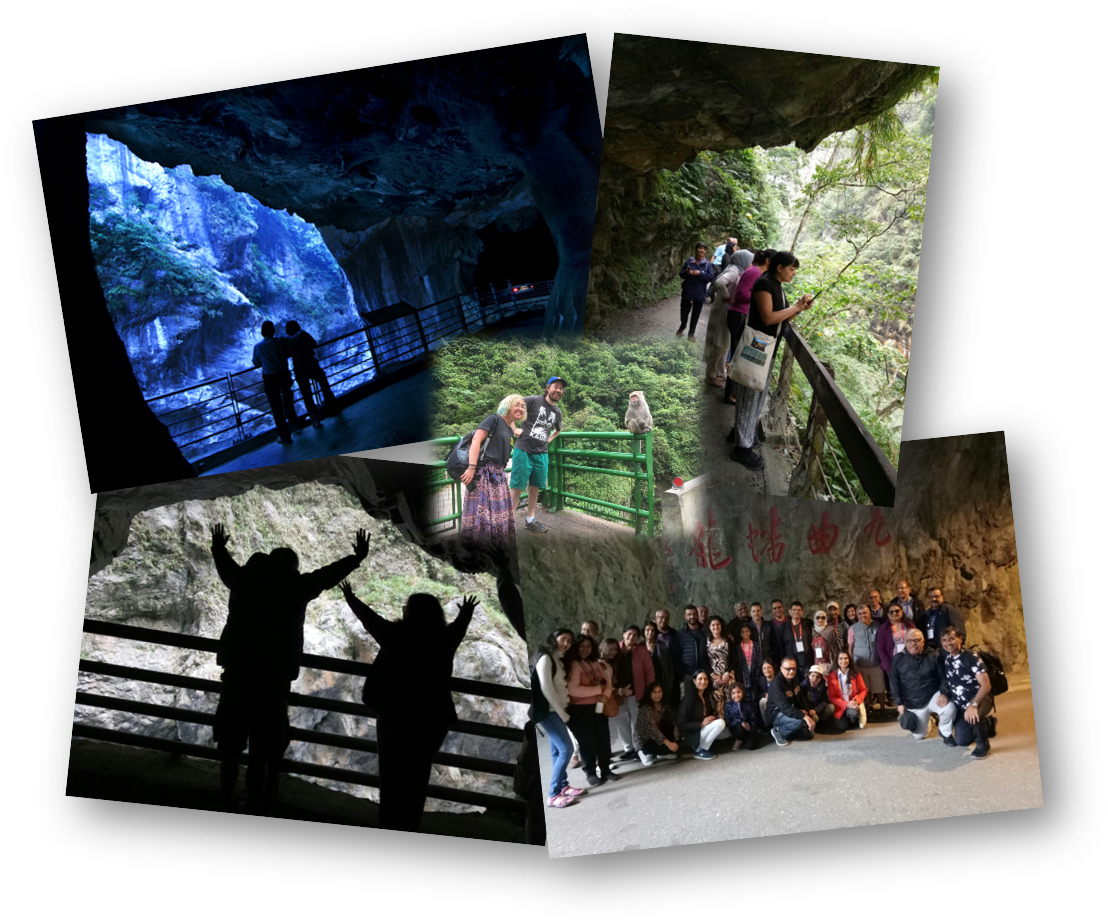
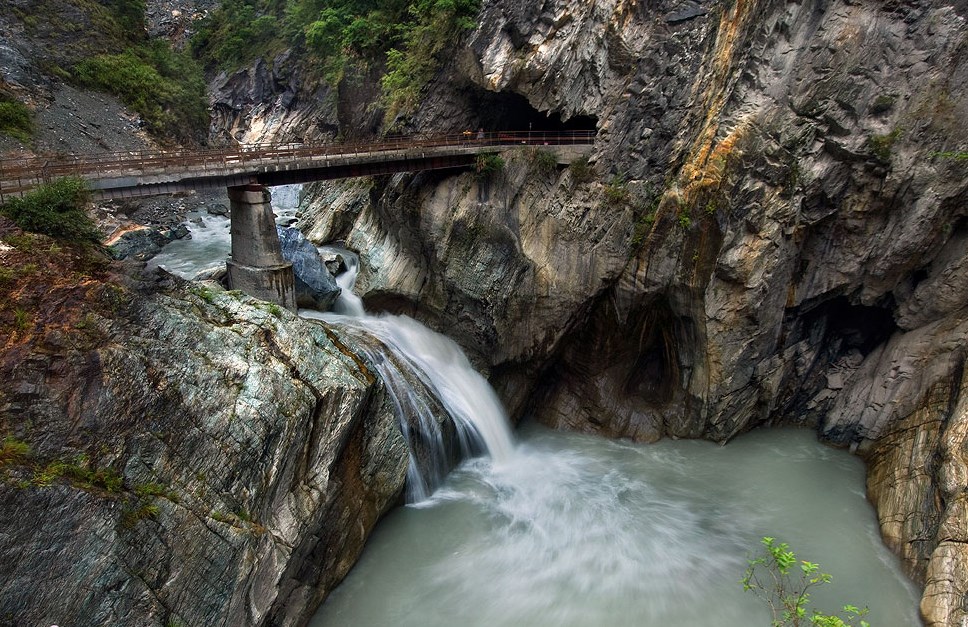
Baiyang Trail
The entrance of the Baiyang Trail is located about 300 meters from Tianxiang on the Central Cross-Island Highway. Near Wen Mountain (Wenshan), hikers will come upon the tunnel that is the beginning of the Baiyang Trail. Along the trail there are six tunnels of different lengths that provide a certain frisson as groups feel their way through the semi-darkness. The longer tunnels have solar-powered lights. This trail is particularly popular with locals, for it has an atmosphere of mystery and romance. A turn in the trail at the end of the third tunnel offers an excellent view of Tacijili River, and at the end of the sixth tunnel the truly spectacular goal of the trail, Baiyang Waterfall, comes into view. The water roars as it plunges into the deep pool that it has worn in the rock. The Baiyang Suspension Bridge offers spectacular views of the waterfall and the river valley. A seventh tunnel leads to a cave behind the falls; because of the danger of falling rocks, this area is closed to the public. Although this trail is not physically challenging, additional clothing may be necessary to ward off chilly air in the vicinity of the Baiyang Waterfall and back takes approximately 1.5 hours.
Swallow Grotto
This part of Taroko Gorge is composed of marble cliff faces covered with small holes, the result of long-term erosion by river and ground water. House swifts and Pacific swallows often forage and nest here, giving the place its name.
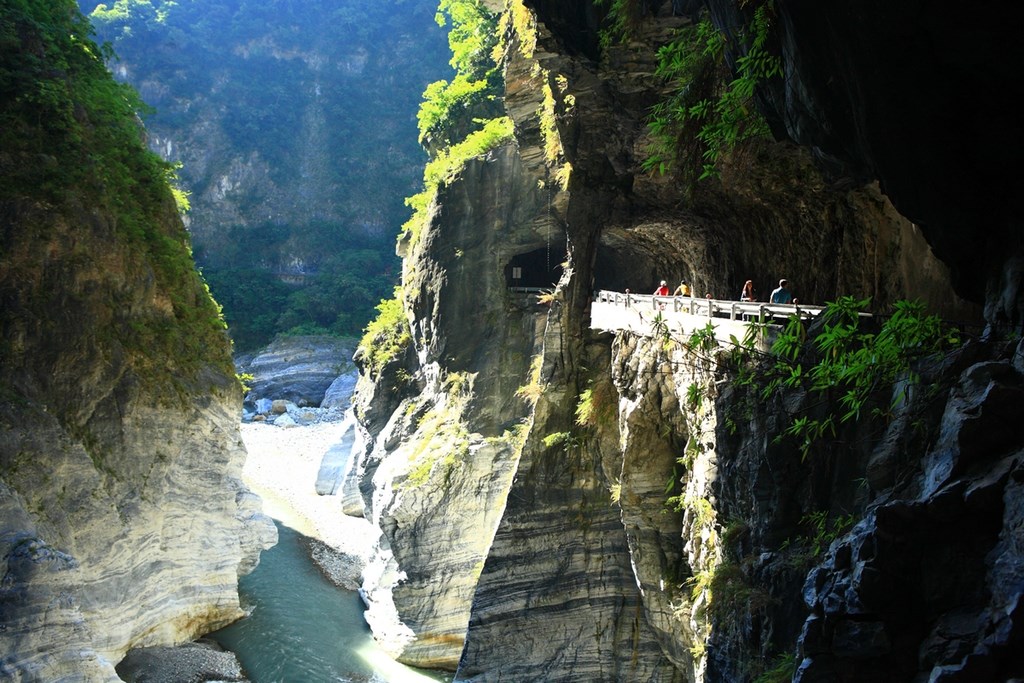
Tunnel of Nine Turns
The tortuous course cut by the river has produced a gorge of many curves, and the path of the highway that has been carved out of the cliff face here seems to be an endless aerie of turns. Hence the name, the gorge is so narrow that only a very narrow width is open to the heavens, in what the Chinese call "a thread of sky." The marble cliff face opposite the highway varies in color from deep gray to pure white in a multitude of changing designs. A walk through the Tunnel of Nine Turns takes about 30 minutes and gives access to enchanting scenes of the gorge, the river, stone strata, the tunnel itself, and the surrounding vegetation. This is one of the most scenic parts of the gorge, and the best place to observe the gorge's ecology.
-
v
v
v
-
Silks Place Taroko
Breakfast at Hotel
Check out and transfer to 1 day tour
Morning: Shakadang Trail / Qixitan Beach
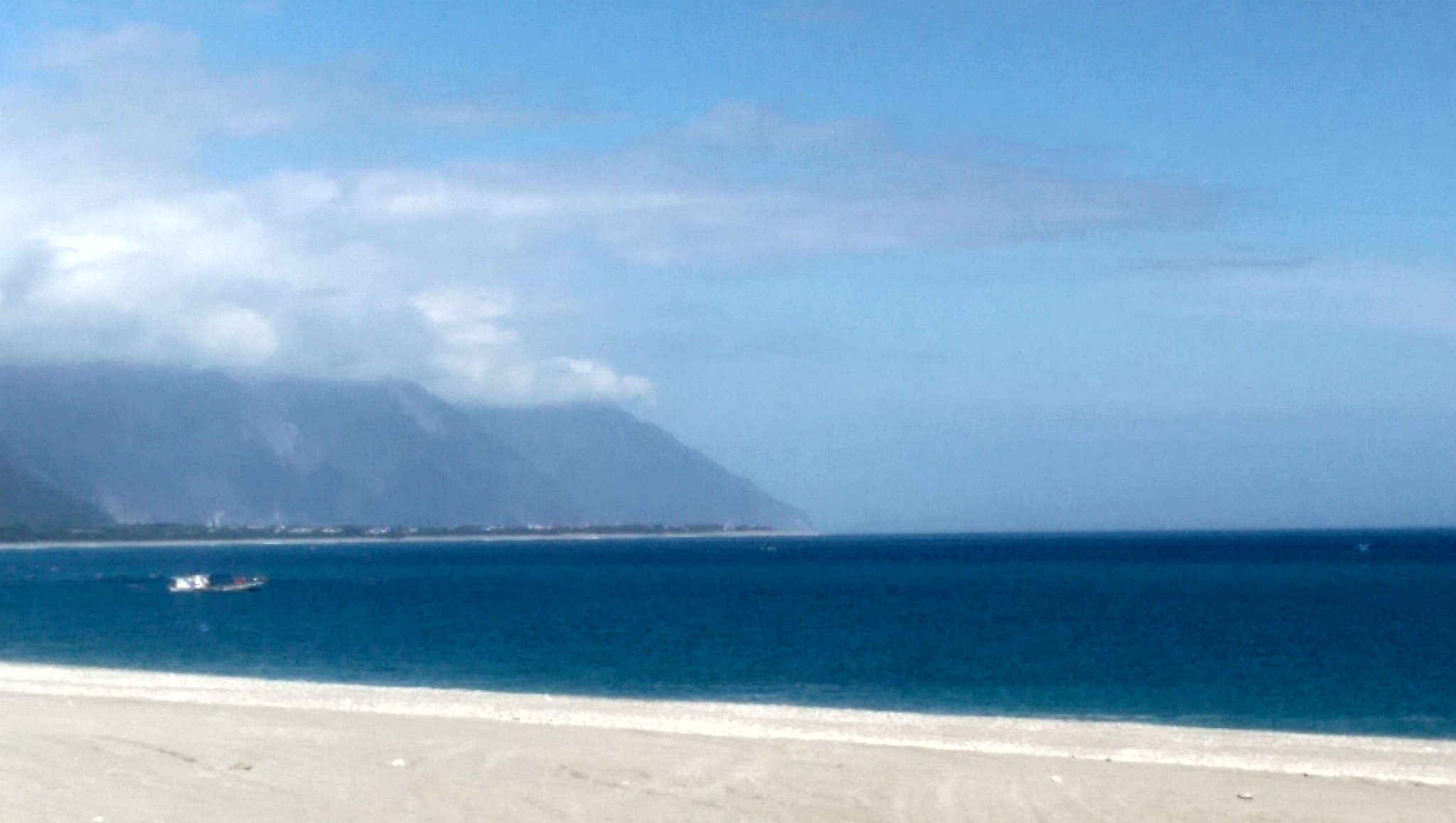
Afternoon: Sanxitai / Xiaoyehliu / Taitung
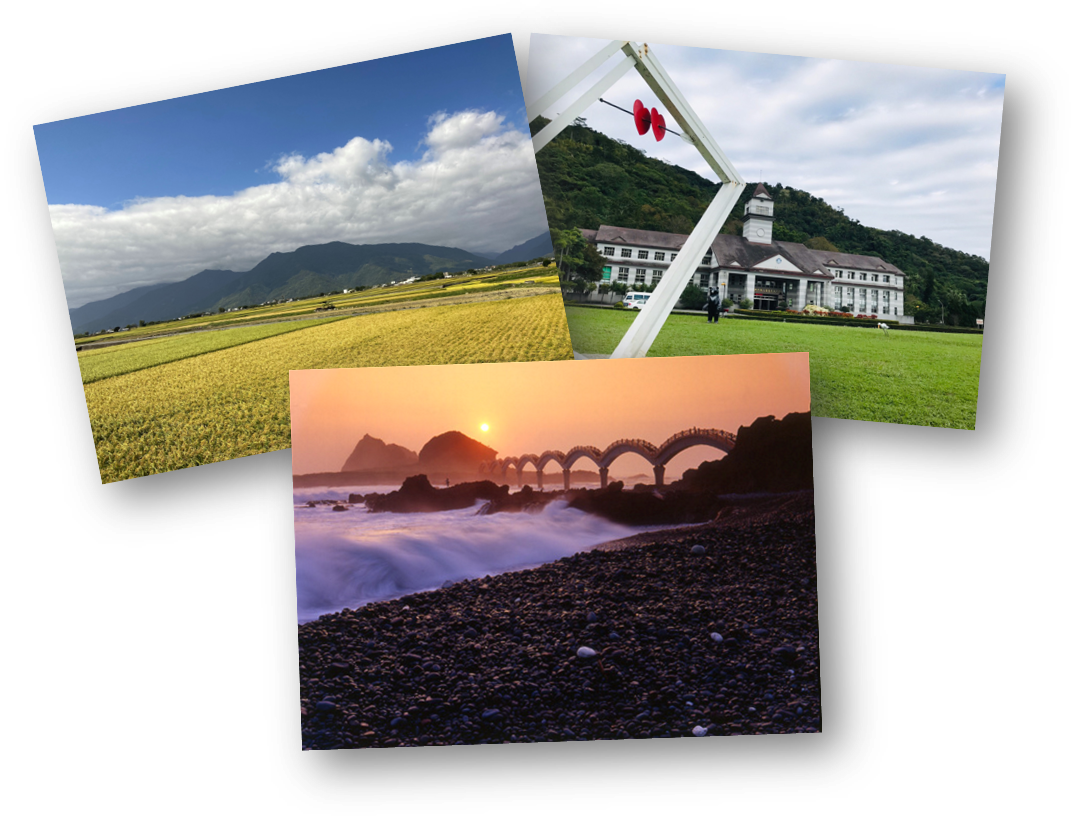

Qixingtan
Qixing Lake (Qixingtan) is located in Beipu Village, Xincheng Township, in the northeast of Hualien City. Visitors can get there via Meilun Industrial Park by following the signs in front of the National Dong Hwa University Meilun Campus. The beach there has an elegant arch shape. The seawater there is clean and blue. The black stones there are crystal. From here visitors can see the great green mountains afar and the twisting highways.
Qixing Lake (Qixingtan) is a poetic name in Chinese. It is said that there were lakes scattered around the National Dong Hwa University and Hualien Airport. They were filled in later as a result of construction. Today, the Qixing Lake (Qixingtan) area refers to the district located in the north of Meilun Industrial Park and Hualien Airport. There are sea valleys formed by faults and elegant bays with rich natural landscapes and cultural resources. From Qixing Lake (Qixingtan) people can look over the Qingshui Cliff. At night, people can appreciate the lights of the new city and Zongde District. There are many sightseeing spots in the area for recreational and educational trips.
The Qixing Lake (Qixingtan) Scenic Area is designated for the bicycle touring. Along the 21km tour from Nanbin Park in Hualien City to the scenic area via Hualien Harbor and the 48 Highlands, there are different views and scenes. The Hualien County Government even built a number of recreational facilities, such as the Stone Sculpture Park, the Star Watching Plaza, the Sunrise Building, and the children's playground. Explanatory notes on the seaside ecology are available near the fishing site. A windbreak forest is used to separate a seaside botanical garden where there are rich resources of seaside animals and plants. You will always be rewarded when traveling here.
-
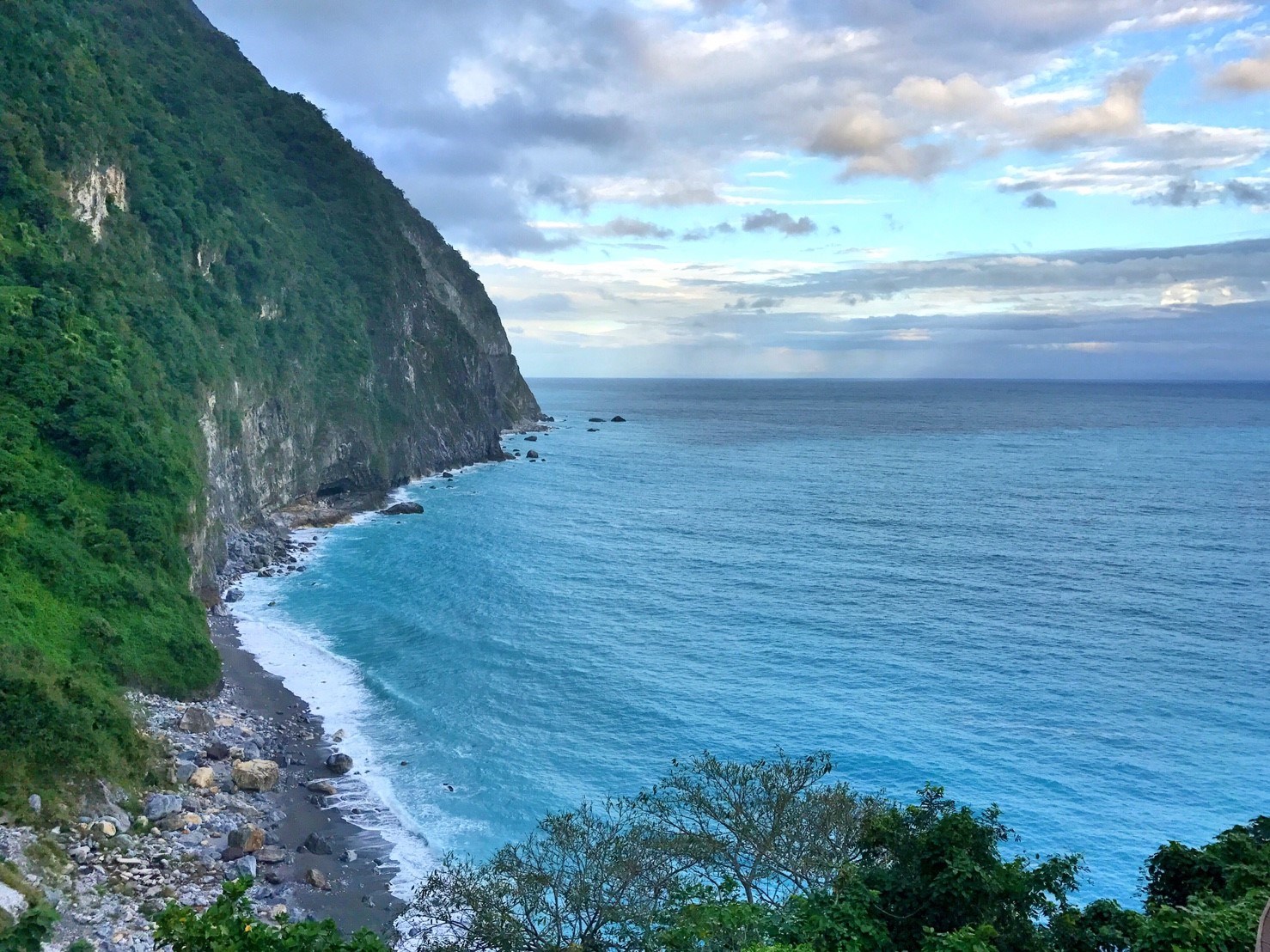
Qingshui Cliff
Qingshui Cliff, located on the section of the Suao-Hualien Highway that stretches between Heping and Chongde stations, is one of the most spectacular sights on Taiwan's Pacific coast. The cliff is more than 1,000 meters high and drops almost vertically into the sea. The highway snakes along its curving face more than 20 kilometers, with the sheer cliff rising on one side and a sheer drop to the ocean on the other.
-
National Taroko Park
Taroko became a national park in 1986, including Hualien City, Nantou County and Taichung City. Taroko is famous for its spectacular mountains and marble canyons. Cliffs and canyons stretch along Liwu River. Four million years ago, the island of Taiwan was formed by the collision of plates. After millions of years of wind erosion, the marble rocks were exposed and cut by Liwu River, creating impressive grand canyons. From Qingshui to Nanhu Peak, the drop height is 3,742 meters. Such special geography has also bred special flora and fauna in this area.
The waterfalls characterized Taroko National Park and the most famous ones are Baiyang Waterfall, Yindai Waterfall, Changchun Waterfall, and Lushui Waterfall. Swallow Grotto (Yanzikou) and Tunnel of Nine Turns (Jiuqudong) are the most impressive natural scenes in Taroko and the canyons here are the narrowest. Tourists can appreciate the natural beauty along the tour track. Swallows nest on the cliff, chirping and flying back forth. The Taroko monumental is designed in Chinese style and Changchun Temple is to remember those who sacrificed their lives for building the central highway. -
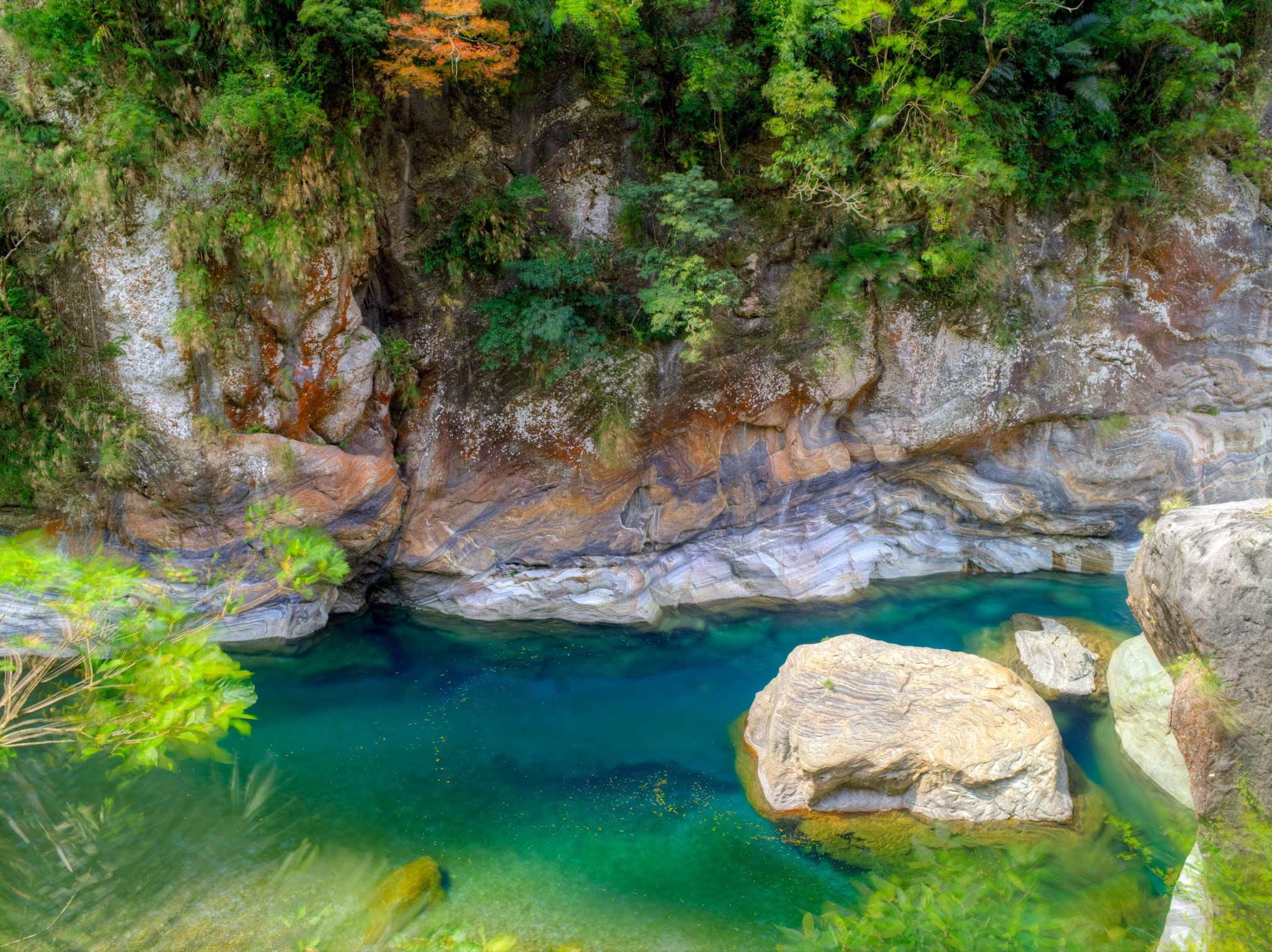
Shakadang Trail
The entrance to this trail is conveniently located only a minute or so from the entrance of Taroko Gorge, behind the Shakadang Toll Station. To reach the trailhead, follow the path behind the toll station that leads down toward Liwu River. After crossing the stream, follow the bank until the river forks at the Shakedang tributary. The trailhead can be found nearby on the right bank of the tributary.
Prospectors seeking the gold sand for which the river was known cut this trail during the Japanese occupation. Although the gold has been fully exploited, the sunlight on the clear water produces a different and perhaps even more beautiful glimmering sight. And after walking for about 25 minutes along the trail, hikers reach a platform. This provides an excellent view of the emerald green waters of Shakadang Stream and the folded strata of marble that form its banks. A wooden walkway leads away from the main Mystery Valley Trail and follows the stream. On weekends, this is a very popular spot, and for those looking to enjoy the tranquility of nature, continuing along the main trail probably offers greater potential. A leisurely progress to the top of the trail and back takes approximately 4~5 hours.
-
v
v
v
-
4-star or 5-star hotel in Taitung
Breakfast at Hotel
Check out for 1 day tour in Taitung and Kenting
Morning: Beinan Culture Park/Tiehau Music Village
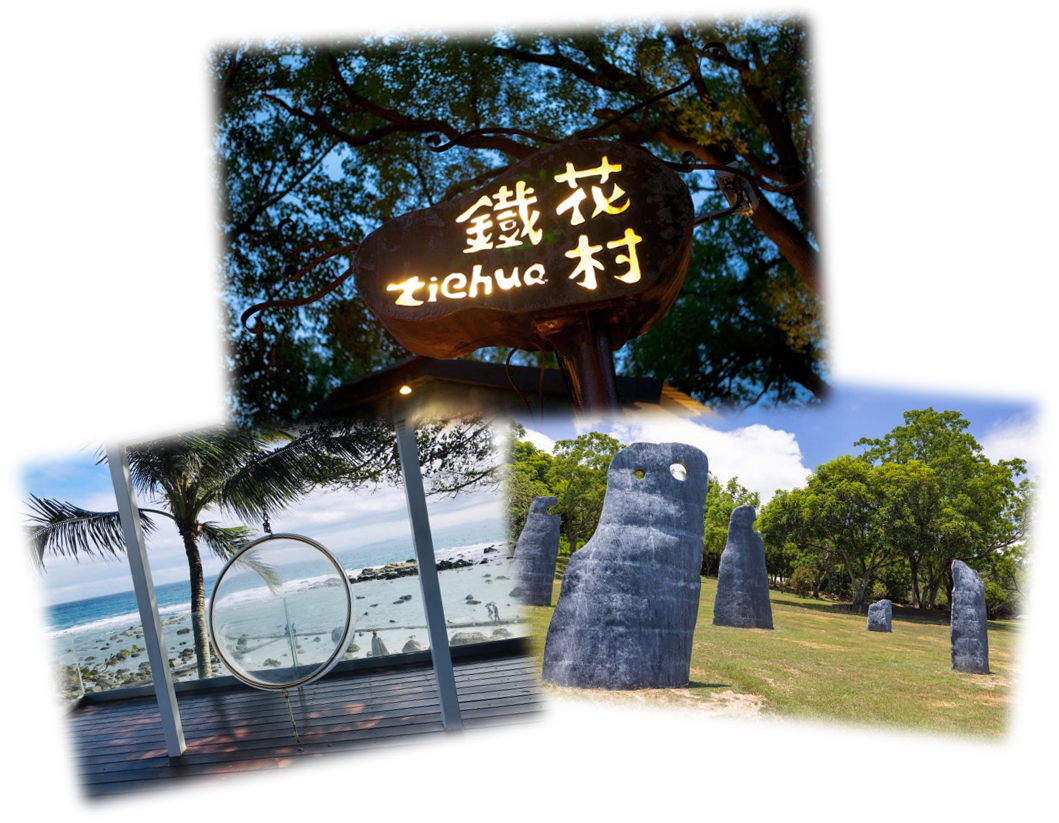
Afternoon: Erluanbi Lighting House / Kenting Street Area
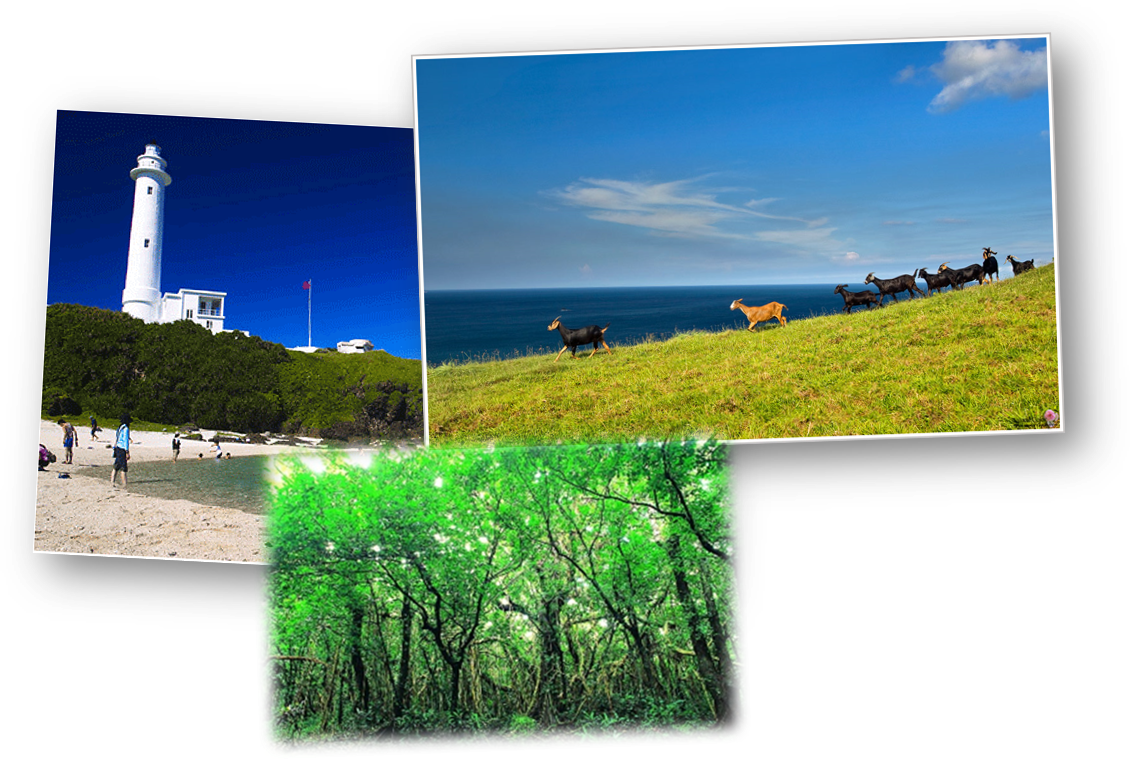
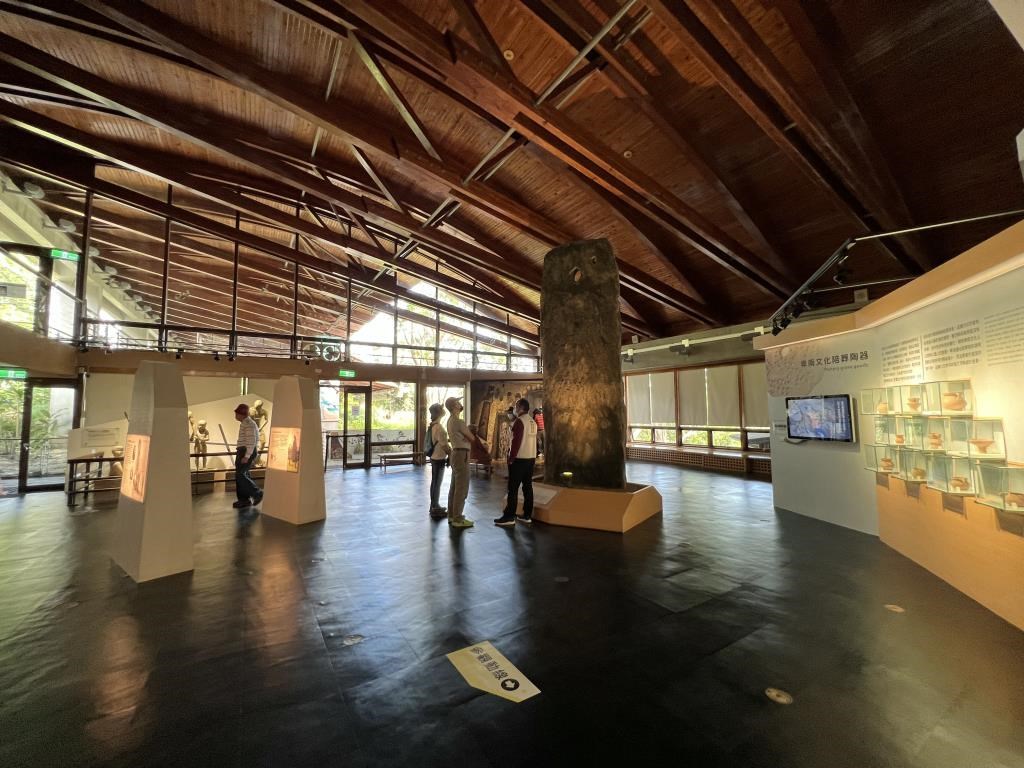
Beinan Site Park
Beinan Site Park is situated at the northern edge of Nanwang Village of Beinan Township in Taitung County. This is the site of the largest and most complete prehistoric settlement that has been discovered in Taiwan so far; in its heyday, the settlement may have covered an area of more than 300,000 square meters. It was found during construction work on the back part of Taitung's New Railway Station when the South-Link Railway was being built in 1980, when a graveyard containing several thousand slate coffins was unearthed. This is the largest prehistoric graveyard yet discovered around the Pacific Rim. The bringing to light of this cultural layer from under the ground caught the attention of the government, and in addition to the carrying out of archaeological work there a national museum to house the resulting artifacts was also built. Besides the coffins, the remains of buildings as well as implements of life used by the Neolithic Beinan people who lived here 2,000 or 3,000 years ago. From their pillared houses, the rich forms of the artifacts they left behind, the exquisite nature of their handicraft, and their burial customs we can catch a glimpse of the high level of civilization attained by these people. In addition to the museum, the park contains the archaeological site that you can visit; if you make prior arrangements for a volunteer guide, you can even have a guided tour of this interesting site.
-
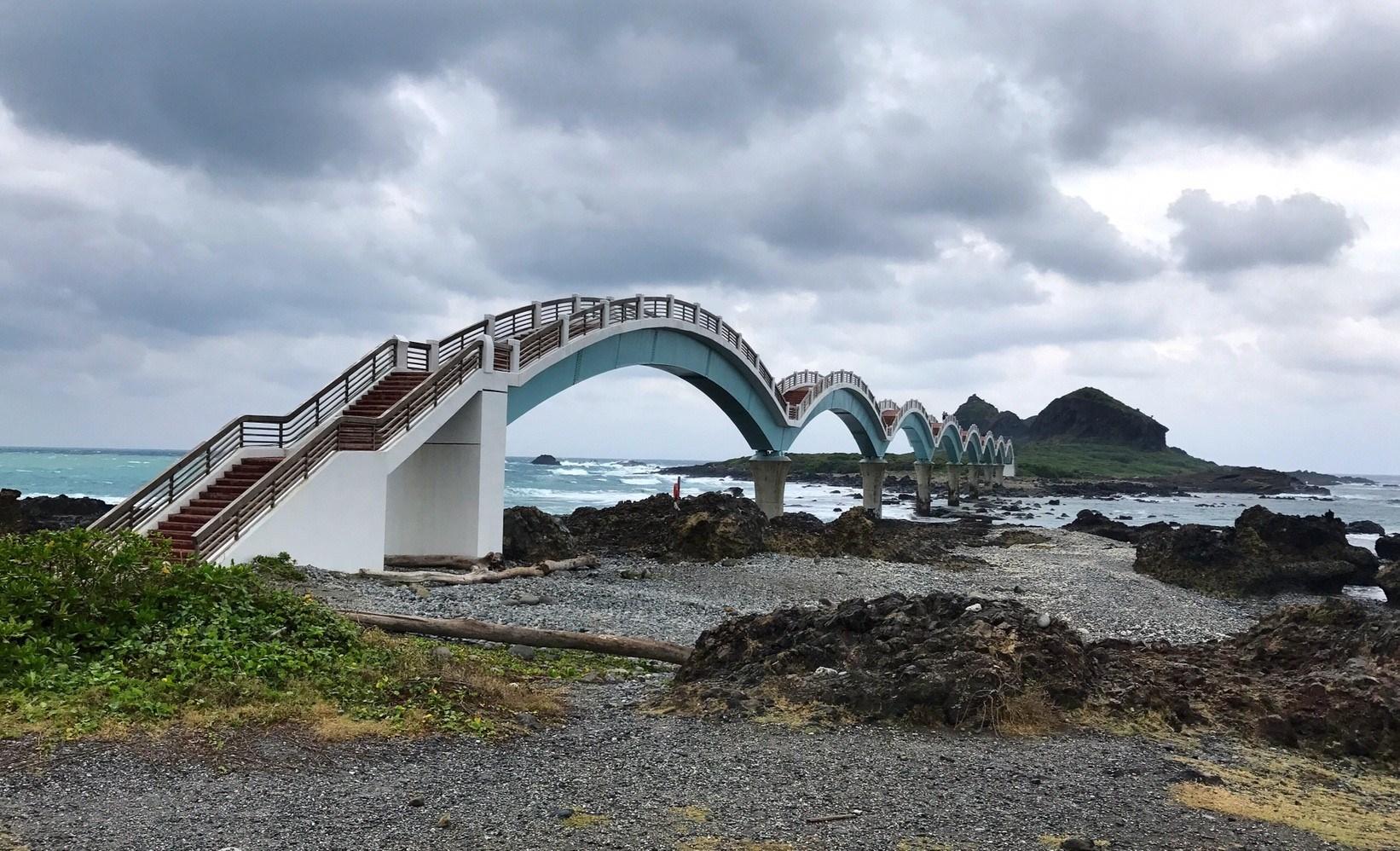
Sanxiantai
Situated at the 110.5-kilometer mark on the coastal highway, Sanxiantai consists of a headland facing a small island in the sea. The three huge rocks that make up the island's most prominent feature have given rise to a local legend that three of China's Eight Immortals once landed there; hence the name of the island, which means "terrace of the three immortals." The island was once connected to the headland by a neck of land which has been eroded away; it is now connected by a red, scalloped footbridge, and the island has a network of footpaths for viewing its geological features such as potholes and sea-eroded caves and trenches, as well as rare coastal vegetation. The island is surrounded by coral reefs and a multitude of tropical fish, making this an ideal spot for skin diving.
Sanxiantai Visitor Center
Sanxiantai is one of the most popular scenic spots in East Coast. You can find out more about these natural wonders and ecology of this area before departing on your tour from the Sanxiantai Visitor Center. -
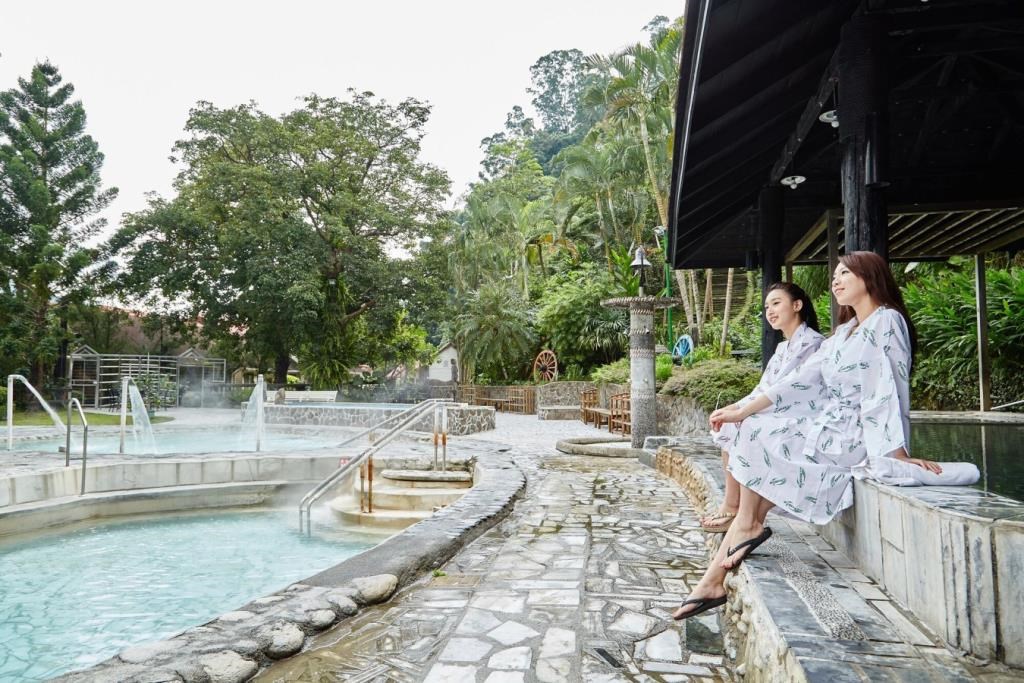
Zhiben Hot spring
Zhiben (Jhihben) Hot Springs have the reputation of being "the greatest scene in eastern Taiwan." In the early years, hot springs emerged from riverbeds. There are carbonic acid springs (with the nature of base). There are colorless, odorless and their temperature reaches more than 100 degrees (Celsius). The springs are of high quality.
Zhiben (Jhihben) is divided into the inner hot spring area and the outer hot spring area by the Zhiben (Jhihben) Creek. Inner hot spring area was developed late. However, due to presence of five-star resorts, the area has become the largest business district. It attracts many foreign tourists who demand services of higher quality.
The "Zhiben (Jhihben) Hot Springs" generally known by the public is located in outer hot spring area. There are many middle-size and small hot spring inns. It is convenient to get accommodation or enjoy hot spring spa. Now the inner hot spring area and the outer hot spring area have expanded and joined together. However, the inner hot spring area is close to Zhiben (Jhihben) Forestry Park and its scenery is even better.
Zhiben (Jhihben) Hot Springs are the gathering place of aboriginal people. It provides the delicious dishes of aboriginal people and country dishes. Other than stores of country dishes, there are venders selling fruits like Shijia (sugar-apple), pineapple and Luoshenhua (roselle). It has the flavor of eastern Taiwan. -
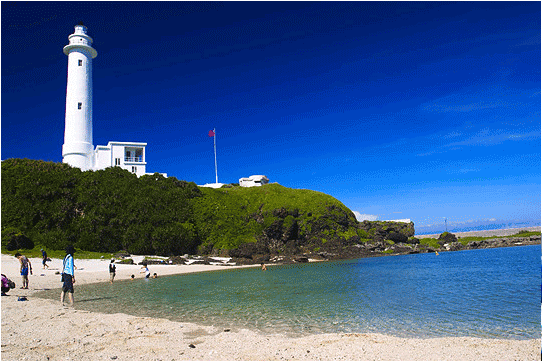
Eluanbi Lighting House
Kenting's rugged coastline provides some of the area's most outstanding attractions. The most prominent of these must be Eluanbi, also known as "Taiwan's Tail." This is the island's southernmost point.
Eluanbi Park was created in 1982 to provide an appropriate venue for people coming to visit Taiwan's southernmost point and one of the peninsula's most notable landmarks, the Eluanbi Lighthouse, also called "The Light of East Asia." It stands 21.4 meters high and is reputedly the brightest lighthouse in Asia. The park covers an area of 59 hectares. Within the park there are a number of recreational facilities and a wide range of interesting geological, botanical, and ornithological features. The area covered by the park is also one of the sites of Kenting's prehistoric cultures.
-
v
v
v
-
4-star or 5-Star Hotel in Kenting
Breakfast at Hotel
Check out and transfer for 1 day tour in Kenting/Kaohsiung
Morning: National Kenting Park
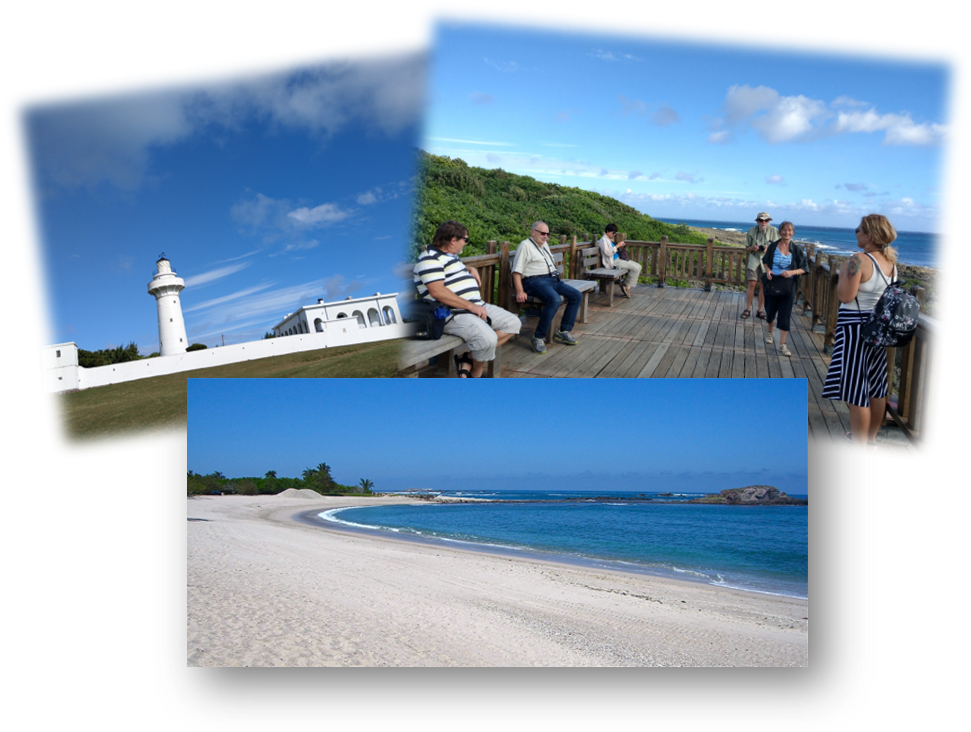
Afternoon: National Kaohsiung Center for the Arts(Weiwuyin)/Formosa Subway Station / Pier 2 / Liuhe Night Market
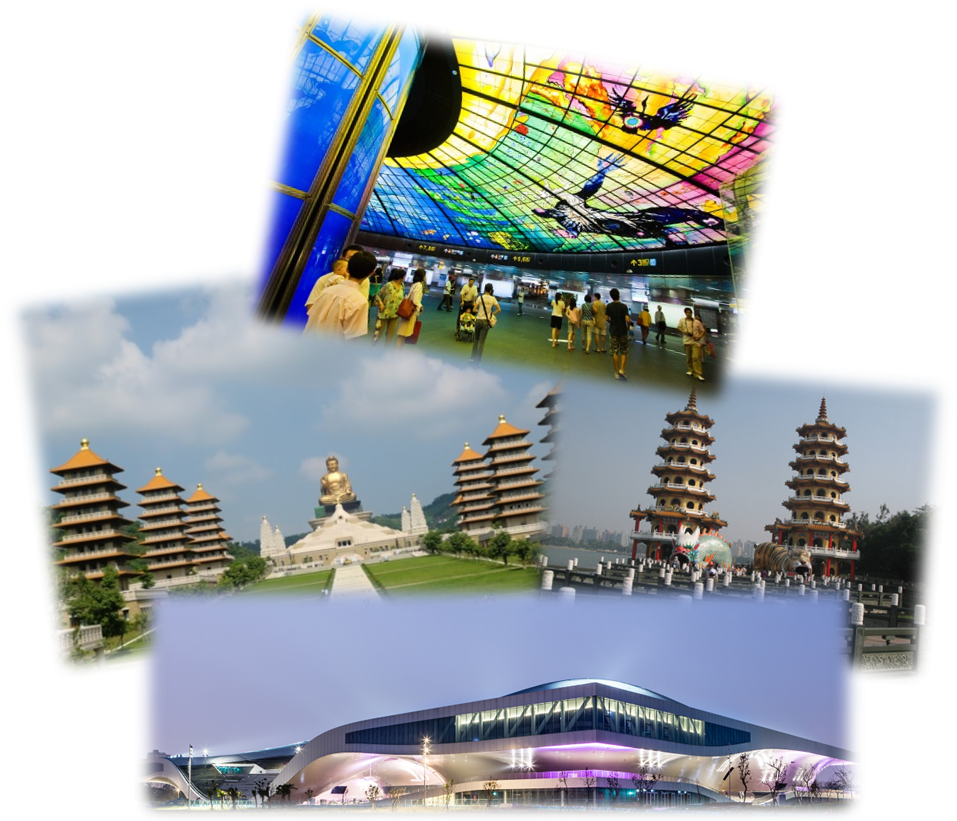
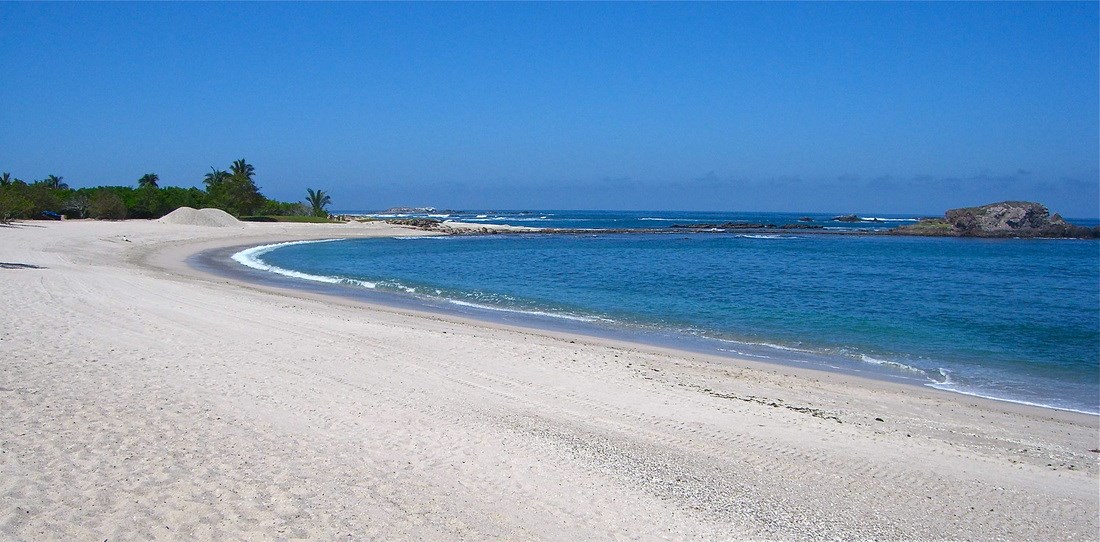
Kenting National Park
The centerpiece of the Hengchun Peninsula is Kenting National Park, Taiwan's only tropical national park. Established in 1982, Kenting National Park covers a total area of 33,268 hectares of land and maritime environments.
This is Taiwan's most densely populated national park, and it includes large stretches of agricultural land's providing visitors with a view of typical Taiwanese rural life. In addition, the national park includes mountains, forests, pasture, lakes, sand dunes, beaches, and coral reefs imply everything you could desire when you want to get up front and personal with Mother Nature.
National Kaohsiung Center for the Arts (Weiwuying)
Wei Wu Ying Cultural Center is located at the site of a former military barracks in Fengshan District, Kaohsiung City. The 66.6-hectare site is home to southern Taiwan's first international performance art venue and the largest performing arts and music hall in is East Asia. Scheduled to open in October 2018, the center will also provide space for art education and talent development in southern Taiwan.
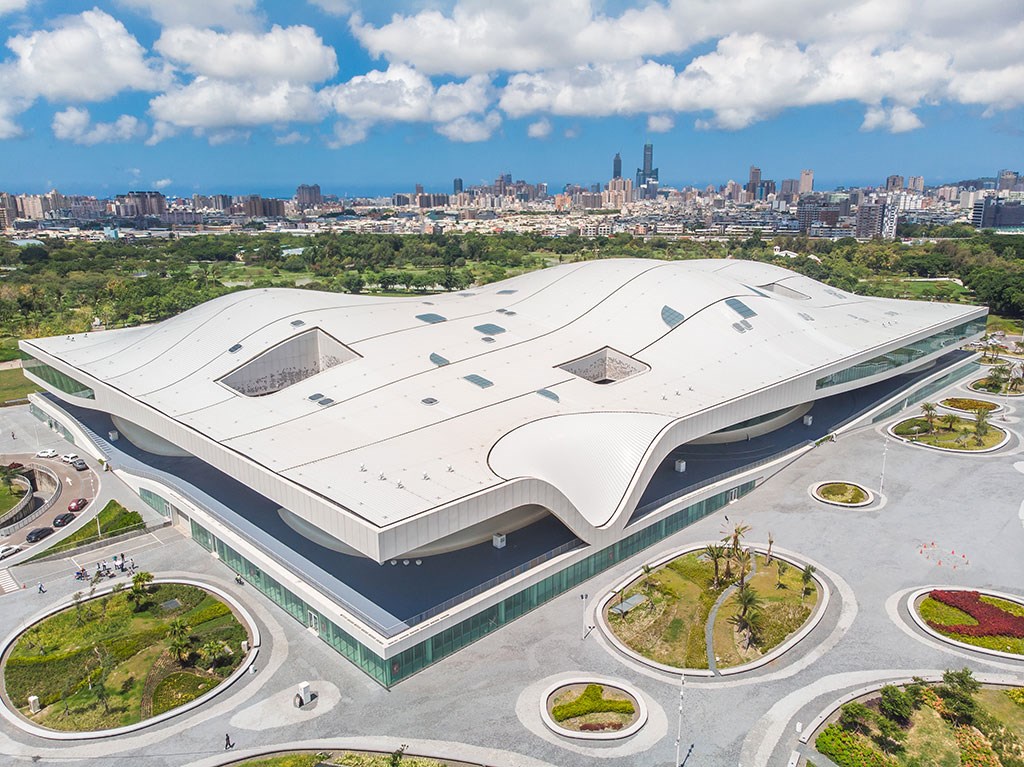
-
v
v
v
-
4-star or 5-star hotel in Kaohsiung
Breakfast at Hotel
Check out and transfer for 1 day tour in Kaohsiung/Tainan
Morning: Lotus Lake / Foguanshan Monastery
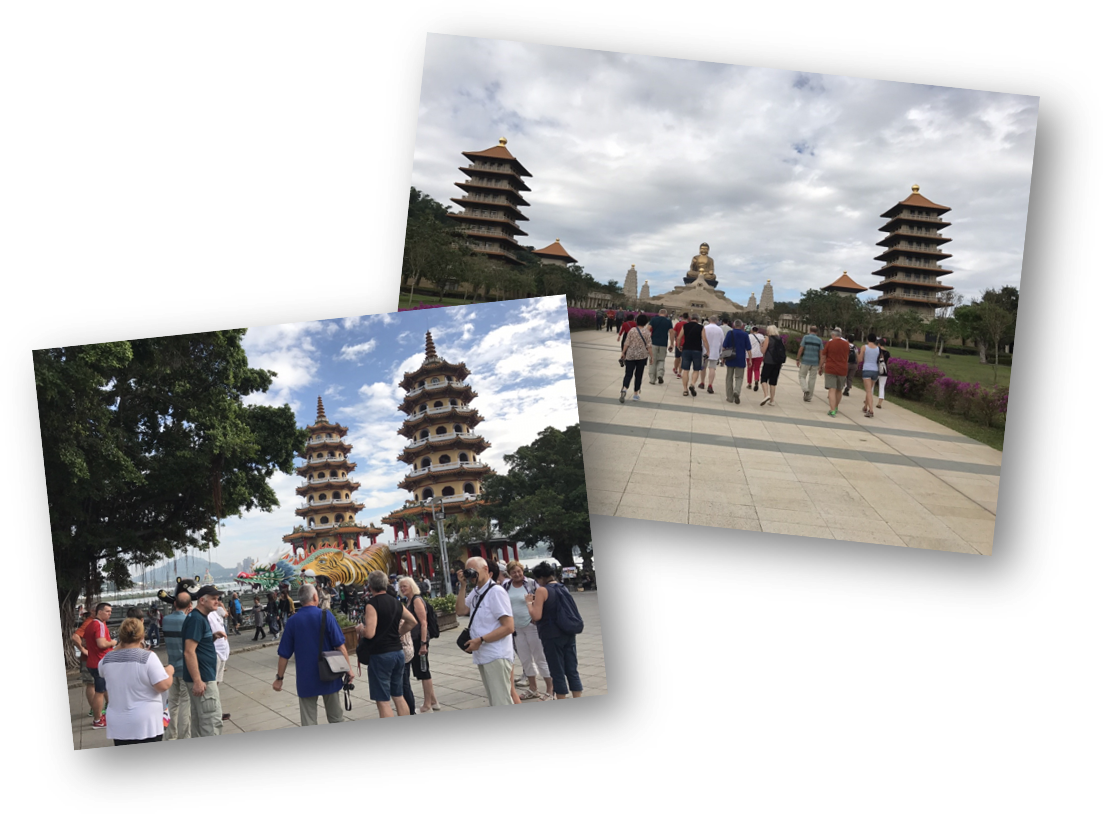
Afternoon: Tainan Confucius Temple/Koxinga Shrine/Anping Fort/Anping Old Street
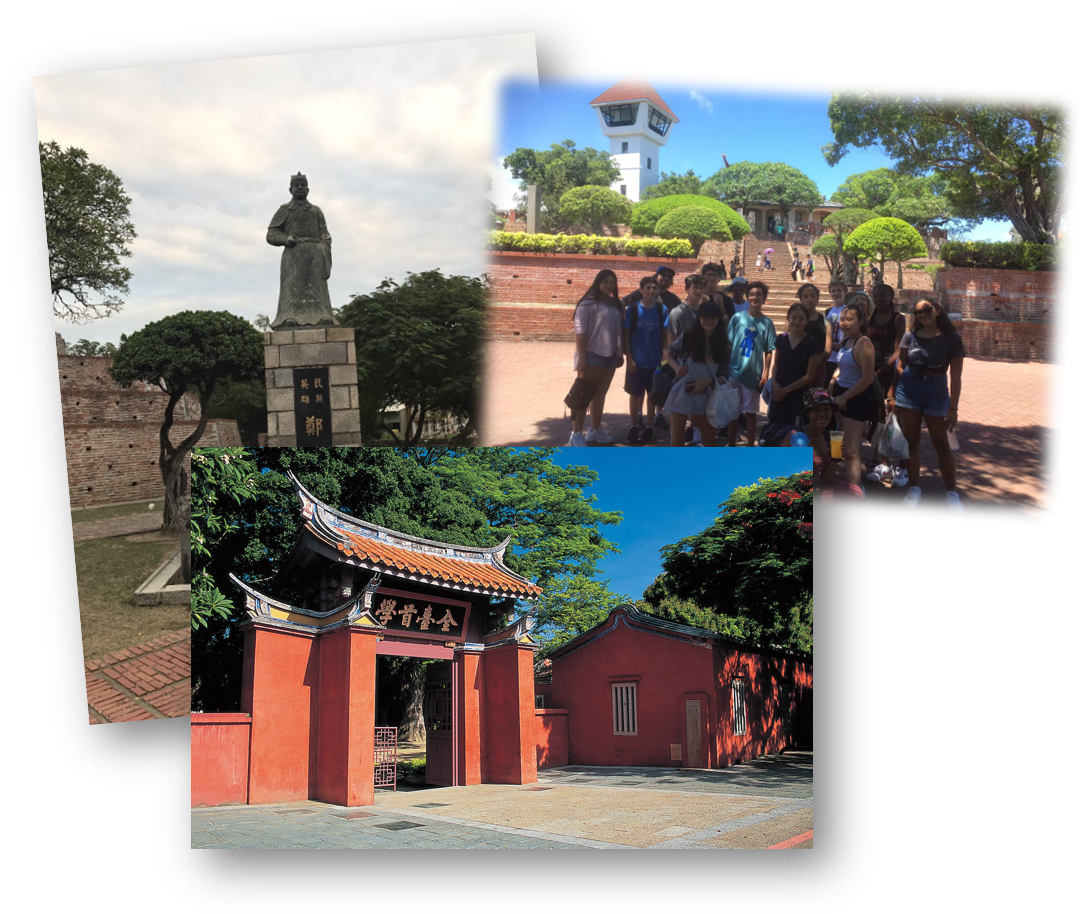
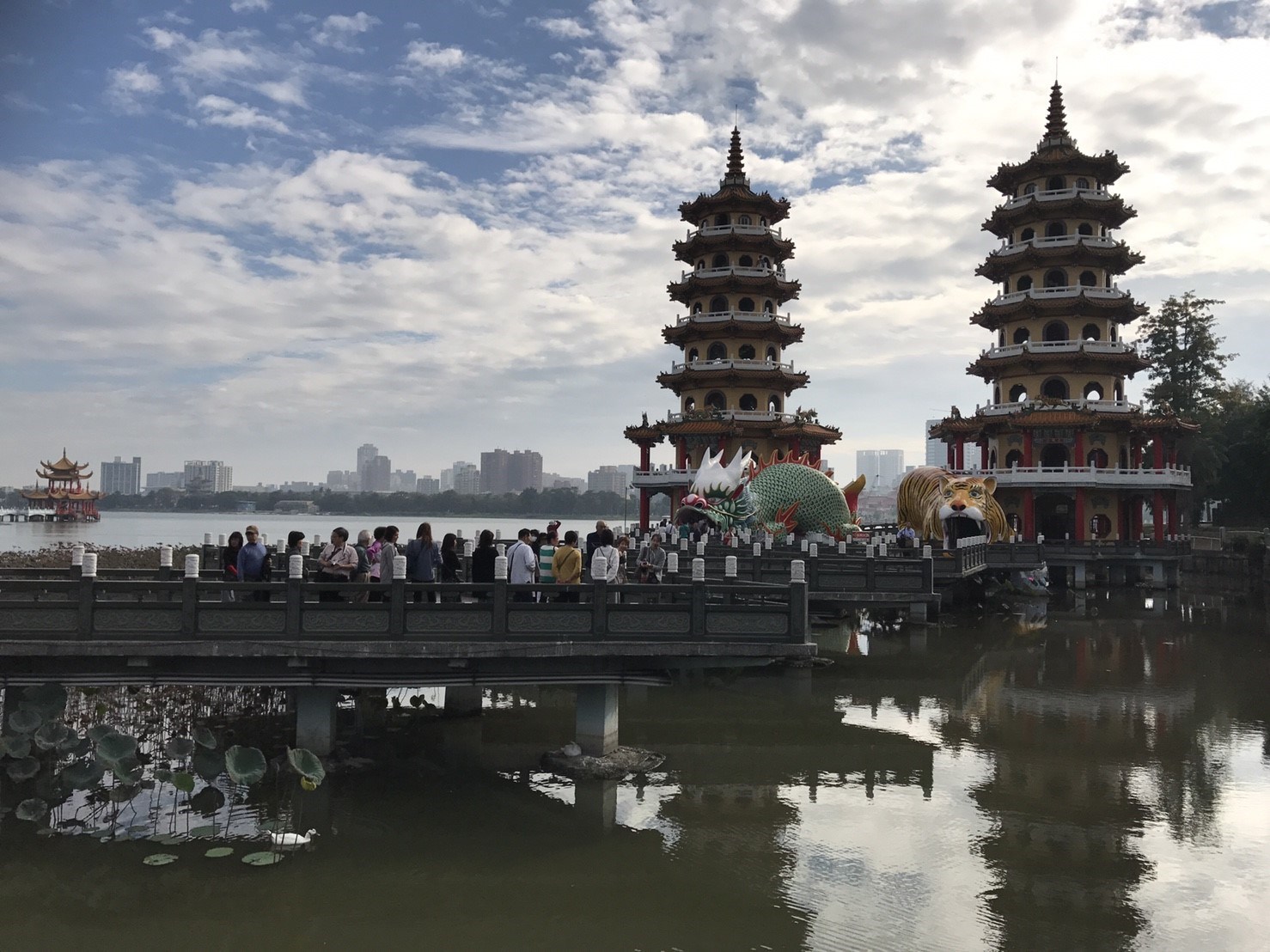
Lotus Pond
Lotus Pond
This famous scenic area on the northern outskirts of Kaohsiung City is noted for its profusion of temples, with the Confucius Temple at its northern edge and, in the south, the Dragon and Tiger Pagodas and the Spring and Autumn Pavilions. The pond is most beautiful in the late afternoon, when the setting sun is reflected in the water. Nearby are the ruins of the Fengshan County walls and gates, which have been designated a first-grade historic.
Spring and Autumn Pavilions
Two massive pavilions dedicated to Kuan Kung, the God of War, the Spring and Autumn Pavilions were completed in 1951. In front of the pavilions is a statue of Guanyin, the Goddess of Mercy, riding a dragon. According to legend, Guanyin appeared above the clouds riding on a dragon, signifying that believers must erect an image depicting this event between pavilions of summer and autumn: The present-day structures are a result of this vision.
Dragon and Tiger Pagodas
About 700 meters to the south of the Spring and Autumn Pavilions are the Dragon and Tiger Pagodas. The dragon's throat is the entrance and the tiger's mouth is the exit. Entering a dragon's throat and coming out a tiger's mouth symbolizes turning bad luck to good fortune. Inside, paintings depict China's 24 most obedient sons as well as scenes of heaven and hell to inspire people to do good deeds during their lifetime, and to provide threatening examples of retribution for wrongdoing.
-
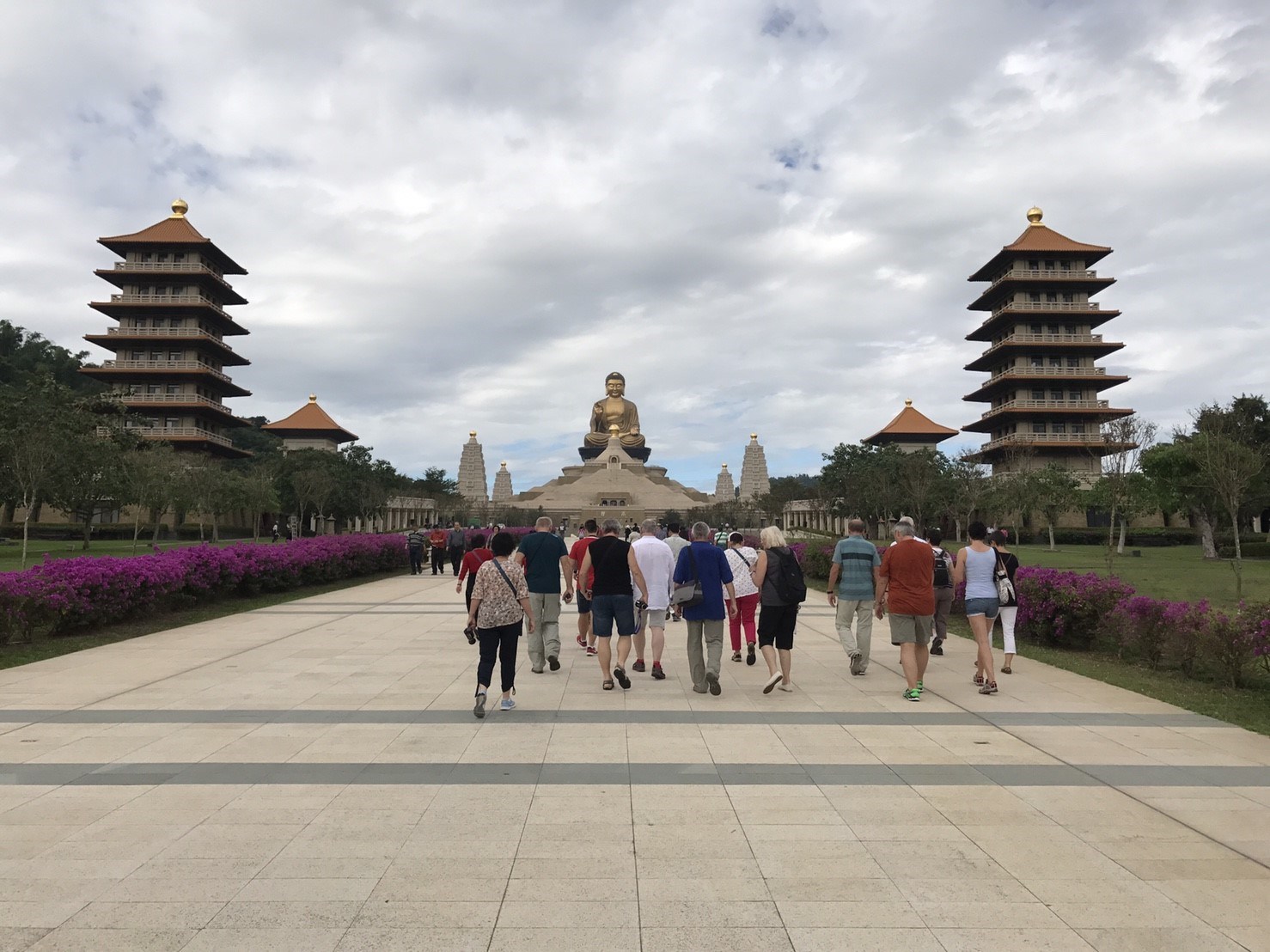
Fo Guang Shan Monastery
At the north-east of Dashu Township in Kaohsiung City on the left bank of the Gaoping river, a famous tourist destination is located. Here you will find the Buddhist center of South Taiwan, established my Master Hsing Yun and his disciples. The architecture of the temples is very characteristic, and at the southeastern side of Fo Guang Mountain (Guang Shan) Monastery the most prominent landmark of the region is found: a huge golden statue of Buddha Amitabha which measures some 120 meters. The main square is surrounded by 480 standing Buddha's, while water and mountains form the magnificent scenery. The main structures consist of four temples, namely the Daxiongbao, the Dabei, the Dazhi and the Dashu shrines. The Daxiongbao shrine covers a large area and is the most imposing of all four shrines. The main god of worship here is Sakyamuni, while statues of Amitabha is placed on the left and right sides. More than 10,000 Guanyin statues surround the temple. Buddha statues and lanterns of light rest in the 14,800 holes in the walls of the four shrines. The site counts more than a thousand Buddha statues, large and small.
-
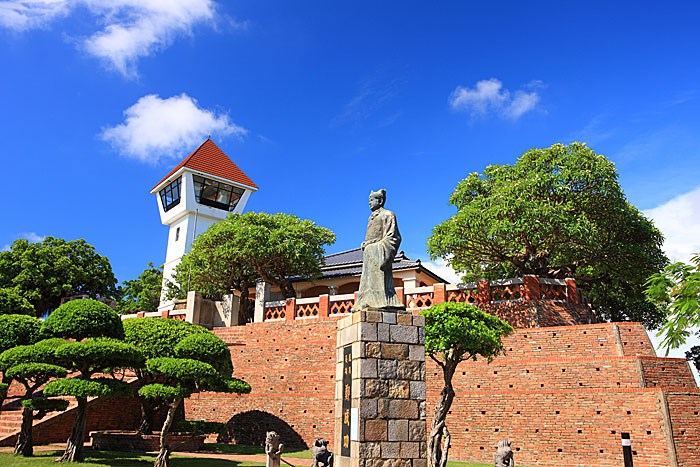
Anping Fort, Tainan
In 1624, Dutch built the first fort in Anping, Taiwan, called "Fort Zeelandia", now known as Anping Old Fort, where has been the administrative center of the Dutch regime, and the hub for trading. The building was originally constructed in square inner fortress and rectangle outer walls. In 1661, the fort was renamed as Anping to commemorate his home town when Koxinga (Cheng Cheng Kung) has driven the Dutch out of Taiwan. Therefore, Fort Zeelandia was also known as "King's Fort" or "Taiwan Fort", nicknamed Anping Old Fort.
In Kangxi Emperor's regime of Qing Dynasty, Taiwan was included in the empire that the political center was transferred to Tainan City, causing the decline of the Fort. The red bricks of the Fort have been taken for construction of Eternal Fortress. During the Japanese occupation, the Dutch style buildings in inner fortress were completely destroyed. A square red-bricked step platform was constructed with a western style house on the platform, being served as dormitory for Customs officials, where the memorial hall now is located. It was named Anping Old Fort after Restoration of Taiwan and become an attraction for tourists. The remaining more than 70 meters long south walls of the outer fort with worn-out red bricks, accompanied by the old banyan roots, chanted its odyssey. The fort is the very historical replica over three hundred years. -
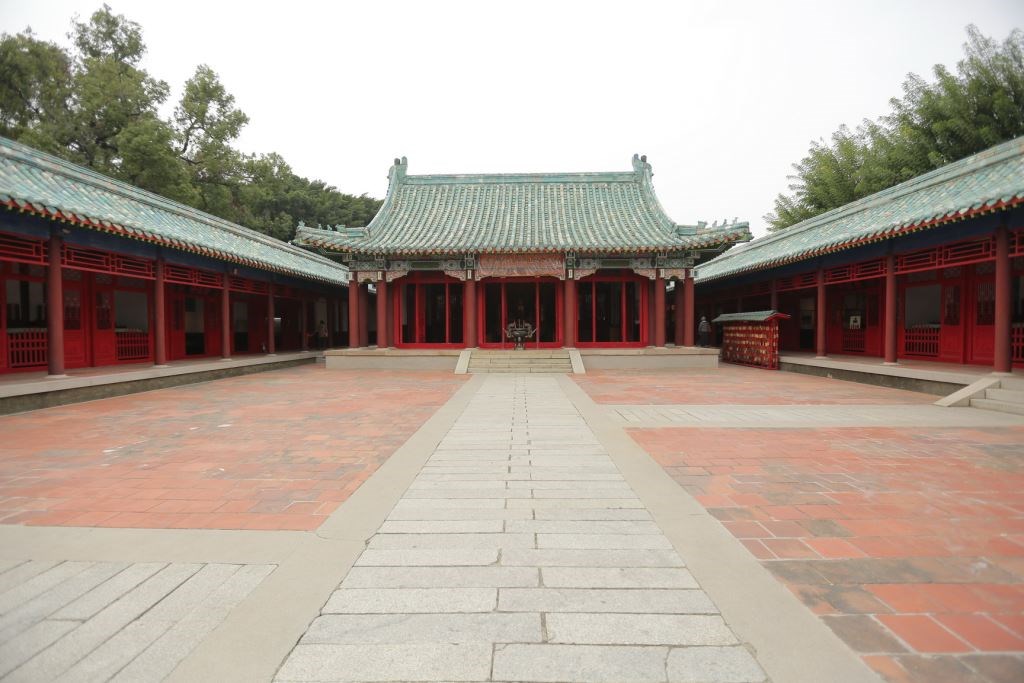
Koxinga Shrine
The Koxinga Shrine (Yanping Junwang Temple), located by Kaishan Road surrounded by trees, is the only Fujianese style shrine in Taiwan. This is the shrine built in memory of the work and achievement of Cheng Cheng Kung, the pioneer of Taiwan. Cheng Cheng Kung was originally called Cheng Sun, a native in County Fujian. His father, Cheng Chi Lung, was a wanderer in his early days. He has been a merchant as well as a pirate. His mother was a Japanese lady called Tagawa. Cheng was born with great intelligence. Not only was he diligent in his studies, he also has a huge ambitious to achieve something big, i.e. to become someone who are good in both academic work and in the military field. By the time he was 21 years old, Wu San Kuei led the Qing army into China and the Ming dynasty thus came to an end. As a result of his father surrendered to the Qing Dynasty and his mother committed suicide, Cheng Cheng Kung suffered a lot of pain and decided that he should turn against the Qing Dynasty to rejuvenate the Ming Dynasty in order to get rid of the shame caused by his father's traitor behavior. In April 1661, which is the 15th year of Emperor Yung Li's reign, he led his army crossing the Taiwan Strait and after 9 months' battle, had finally retrieved Taiwan from the hands of the Dutch. Taiwan thus was no more a colony of the Netherlands. After gaining access to Taiwan, Cheng quickly built up the whole place by setting up governing offices, regulations, education system as well as developing more farm lands to improve the living standards of the local people. He also actively trained people in military tactics, preparing them to fight the Qing army. However, just half year after he had retrieved Taiwan, Cheng died of illness on May 8, 1662. His aim of rejuvenating the Ming Dynasty was unfulfilled which was the biggest regret of his whole life. In 1874, which is the 13th year of Emperor Tongzhi of the Qing Dynasty's reign, emperor's special envoy Shen Bao Chen requested for the enlargement of the then existing Kai Shan Wang' shrine which was in memory of the work of Cheng Cheng Kung. It was approved by the regime and the new shrine was officially called "Koxinga Shrine" and for people to pay tribute to this folk hero.
Inside the Koxinga Shrine, there is the Koxinga Museum where exhibits various historical culture of Tainan. The first floor is for pre-historic preserves and dig-ups. Apart from illustrating the geographic connection between Taiwan and the Mainland, these things also describe the evolution of life from the past to the present. Most of the exhibits in the second floor are the historical materials of Tainan. These include the materials and things related to the concerned ancestors, such as the portraits of Cheng Cheng Kung and Shen Bao Chen, and also their works. In addition, daily items of Tainan city of the old like the street signs, bedding equipment, land deeds, money bills are on exhibition so that the public can understand the daily life of the past generations. It is a cultural spot very worth visiting.
-
v
v
v
-
4-star or 5-star hotel in Tainan
Breakfast at Hotel
Check out transfer for 1 day tour
Morning: Eternal Golden Castle/Chihkan Tower
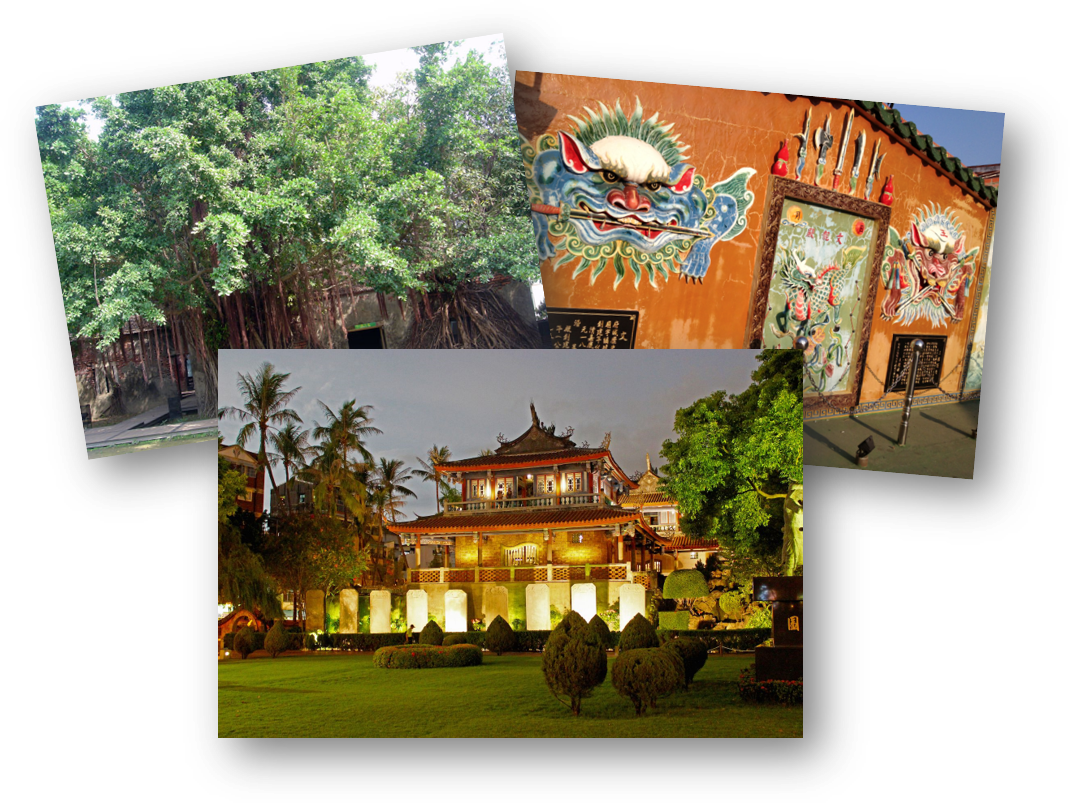
Afternoon: Sun Moon Lake ShiangShan Vistors Center / Wenwu Temple
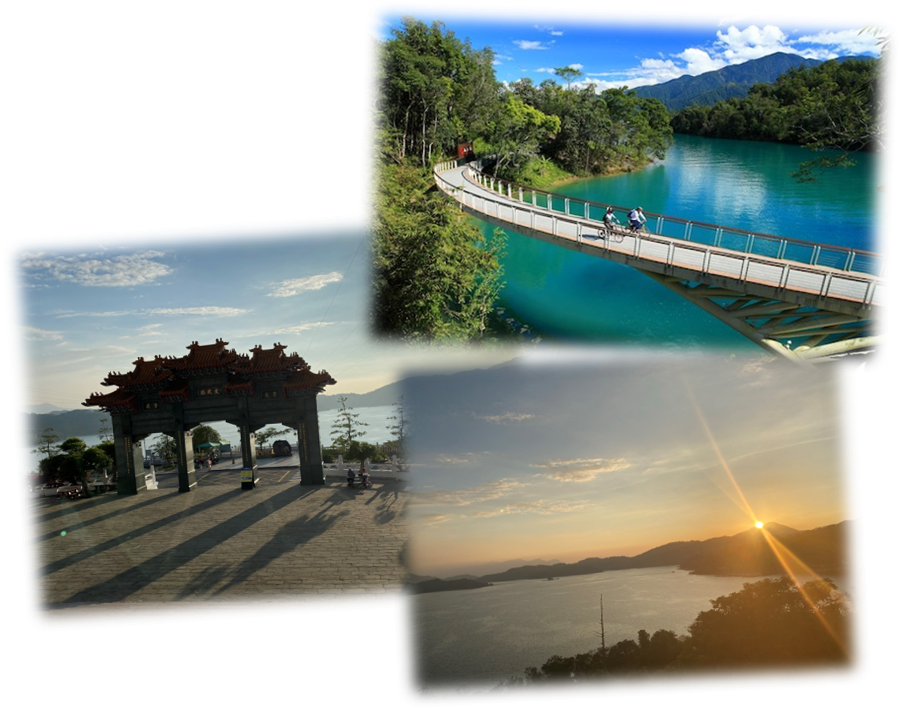
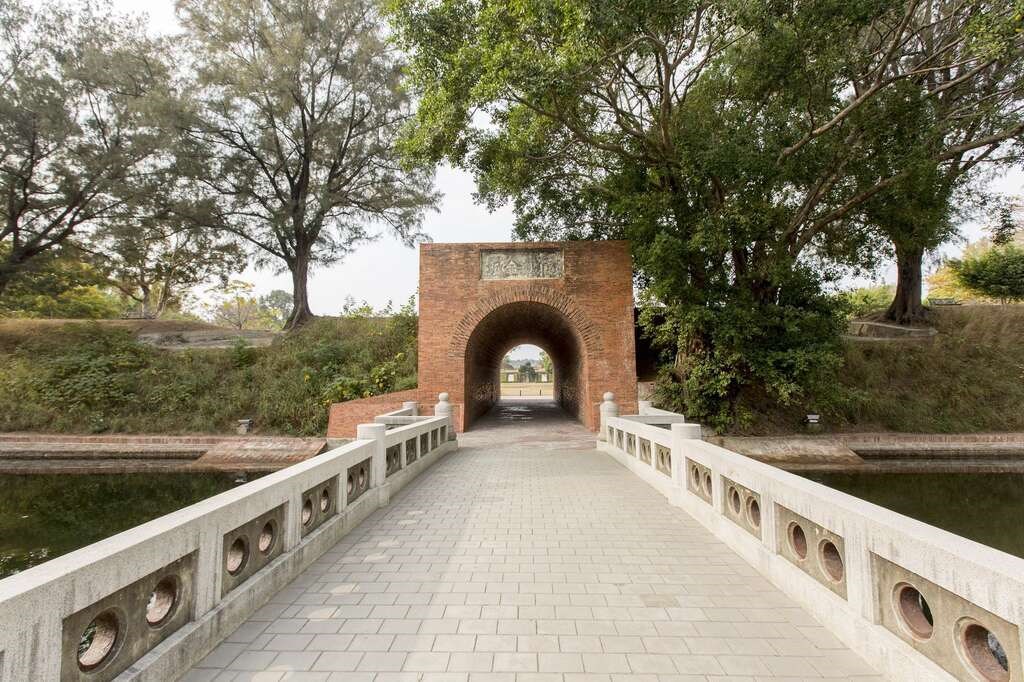
Eternal Golden Castle
Eternal Golden Castle was called "Anping Great Fort" or "Erkunshen Battery" in the ancient time, it was built to resist the Japanese troops who invaded Taiwan due to Mudan incident. When Shen Pao-chen first arriving in Anping in 1874, he believed that Great Forts should be built to protect the city, therefore, the first western style fort was finally completed in 1876, which was designed by French engineers, it was the first port equipped with British Armstrong Cannon in Taiwan, moreover, it was a great step toward modernization of Taiwanese coastguard military defense.
On the construction form, Eternal Golden Castle is a square shape fort belongs to the western diamond type castle, with its four corners protruding, and its center indenting. There are fosses around the fort, and the fort is placed with big and small cannons, while the center of the port is used as exercising field; the shape is of integrity and complete, the scale is huge, supported with powerful fort, Eternal Golden Castle can be seen as the important epoch-making milestone among all forts in Taiwan. The fort was ruined later on, and was once neglected, but later it was ranked among one of the noted sights in the city and was carefully reserved. After the restoration, a major reconstruction was carried out, the shape and the materials were more or less changed.
But after the reconstruction, the original scale can generally be seen. Nowadays, its outer walls are about two meters high, the fosses are around the castle's walls, trees and woods are thickly growing, the bricks laying arched castle gate is 5 meters high, through the arched castle gate, what you can see is a carpet of green grass, flat and wide, there are also memorial brass sculpture of Shen Pao-chen and imitated ancient cannons.
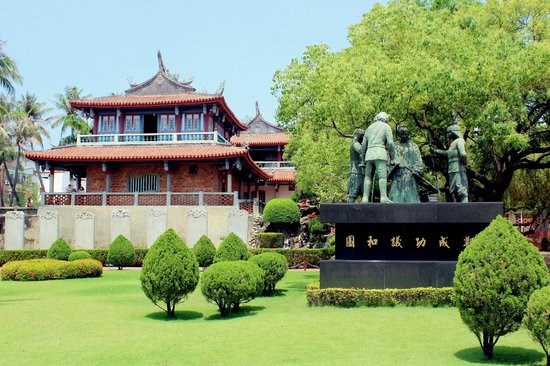
Chikan Tower
Tainan Chikanlou is built by the Dutch in 1653. It was originally called Provintia. In Dutch it means eternity. The Chinese called the building "Chikanlou", "Fanzailou" or "Honmaolou". Although Chikanlou has gone through Ming Dynasty, Qing Dynasty and the Japanese Colonization Period, it basically still maintains its original look.
Chikanlou has been an administration center from the Dutch's occupation period. In 1661, when the Chinese General Cheng Cheng kung repelled the Dutch, Provintia was changed to be Chentien governor's mansion. In the early stage of Qing Dynasty when Taijiang River was still running, the tides could reach Chikanlou directly. "The sunset in Chikanlou " was one of the eight famous scenes in Taiwan. In front of Chikanlou there are nine sets of stone turtles carrying plates. There were made in Qing Dynasty and were removed from elsewhere to be located here. The legend says that the stone turtle is one of the dragon's nine sons. It shifted into a turtle because it loved to endure heavy objects. There is also a stone horse with broken legs. The legend says that the stone horse's legs were broken by force because it shape-shifted into a monster at night and harassed the residents. Later, Chikanlou declined due to damages caused by civilian upheaval and lack of management. Chinese style building was added to the original Dutch architectural body. For a time the place hosted the worship for Guanshiyin Budda. During the Japanese colonization period, Chikanlou was changed to be army hospital. There were some restoration and repair. After Taiwan was returned to R.O.C., the wooden structure was changed into steel concrete structure. The main entrance was changed. Thus they created the look of Chikanlou today.
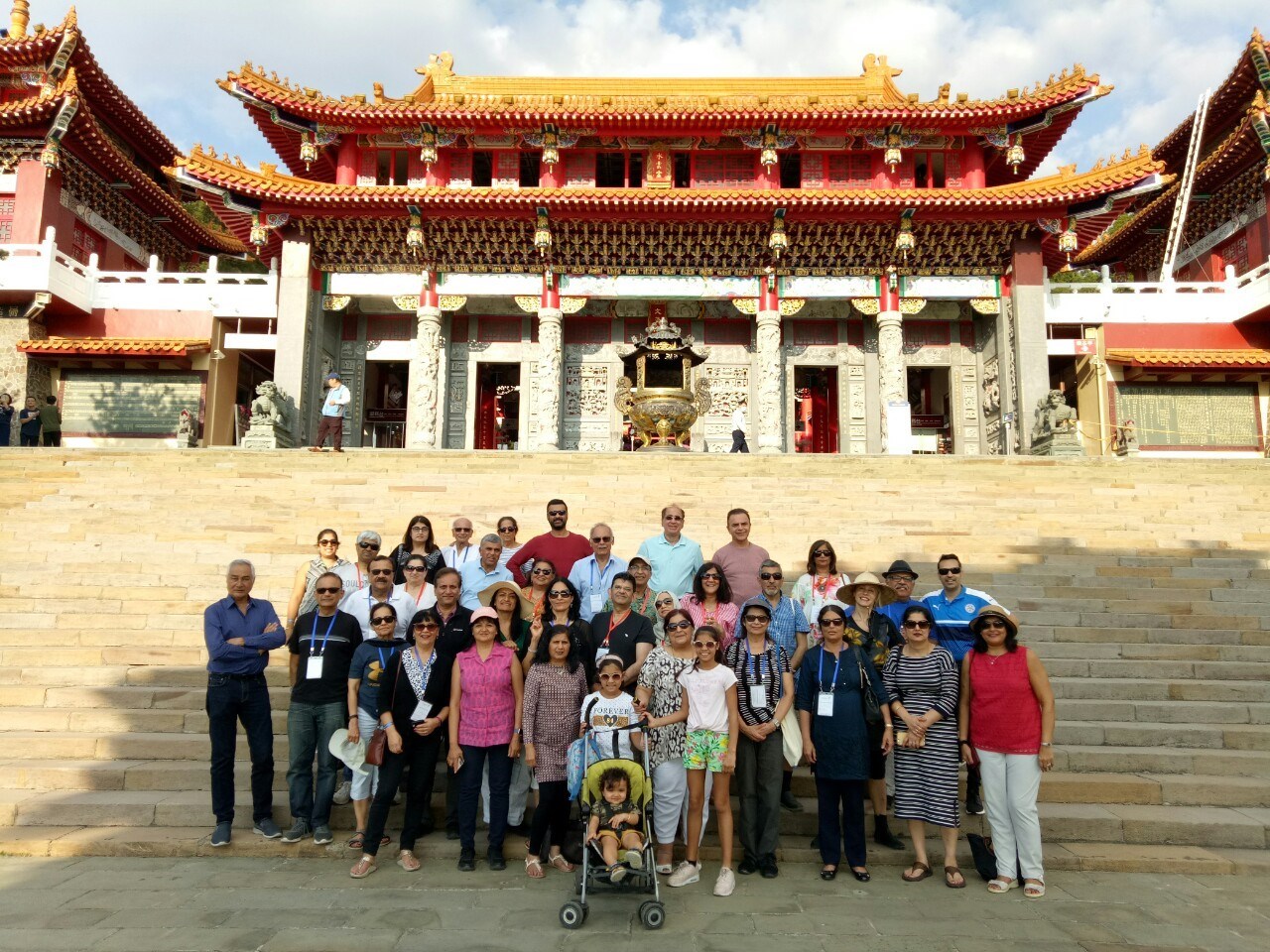
Wenwu Temple, Sun Moon Lake
Wenwu Temple is located at the shoulder of mountain where is on the north of Sun Moon Lake. It was built in 1938. People worried the water of Sun Moon Lake might cover Longfeng Temple and Yihua Hall of Shuishotsun(Ita thao Pier), they built Wenwu Temple. The Wenwu Temple is 2 (Longfeng Temple and Yihua Hall) in 1. It was rebuilt in 1969. Its gate is face to the north. People pray the Civil Saint of Confucius, the Military Saint of Guangong, and the Established God of two temples at the Wenwu Temple. The temple is popular among students.
-
v
v
v
-
4-star or 5-star hotel in Sun Moon Lake
Breakfast at Hotel
Check out and transfer for 1 day tour
Morning: Boat Trip around Sun Moon Lake/ Tea DIY Program
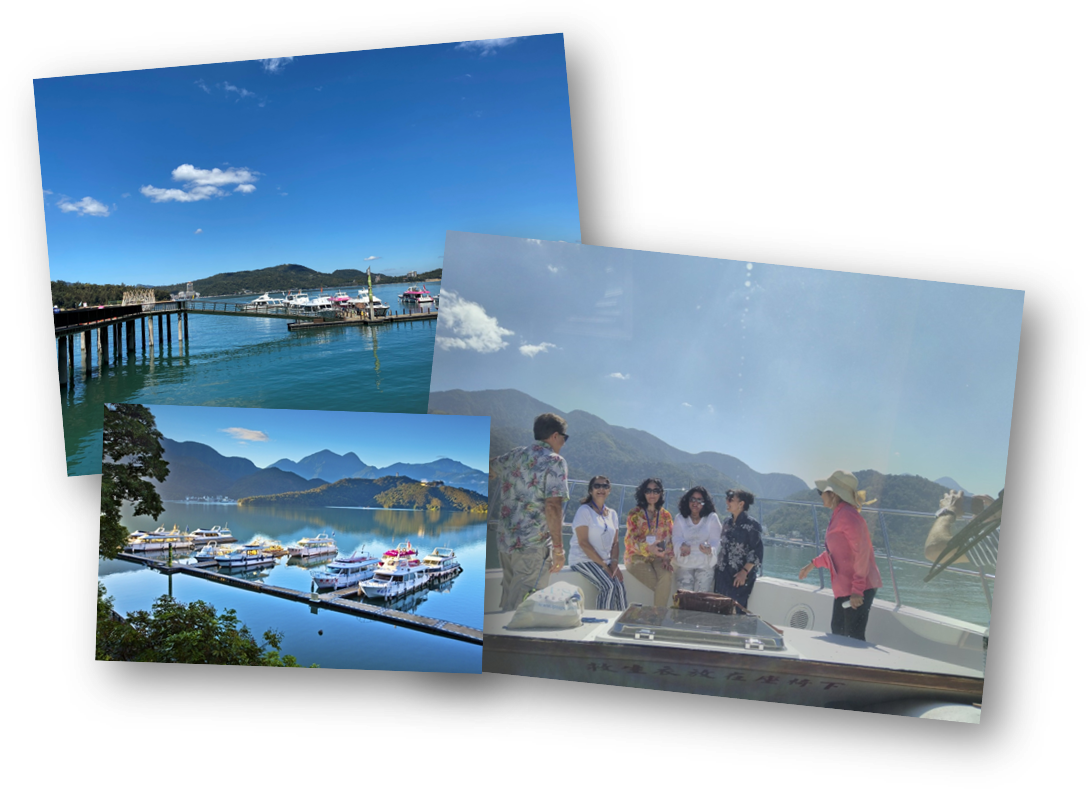
Afternoon: National Taichung Theater /FangChia Night Market
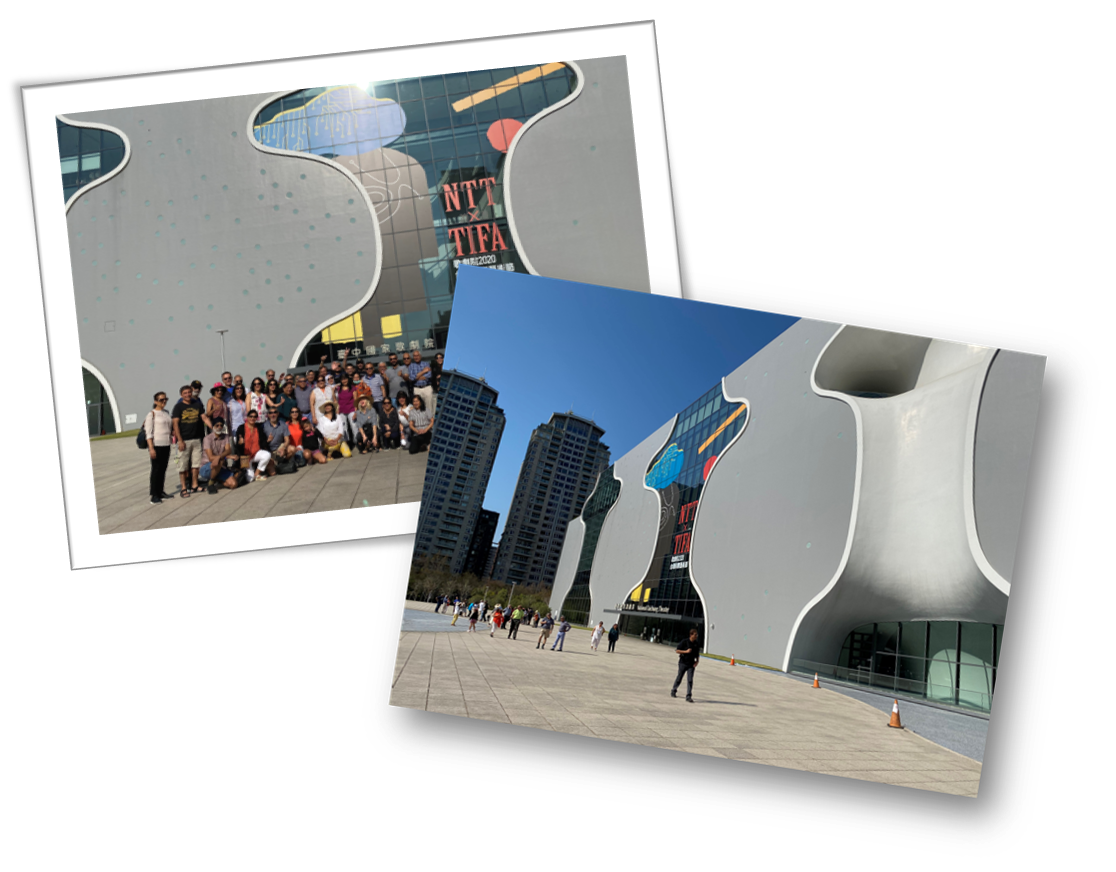
Sun Moon Lake
Sun Moon Lake is a beautiful alpine lake located in the middle of Taiwan.
Enjoy the most special experience in the water, land and air.
Sun Moon Lake National Scenic Area has a rich indigenous culture, and excellent agricultural products. Come here to enjoy bike riding, cable car and boat rides, or take the little train at Jiji and experience the nostalgic Taiwan railway. It will leave you with the most wonderful and lasting memory of your trip!
-
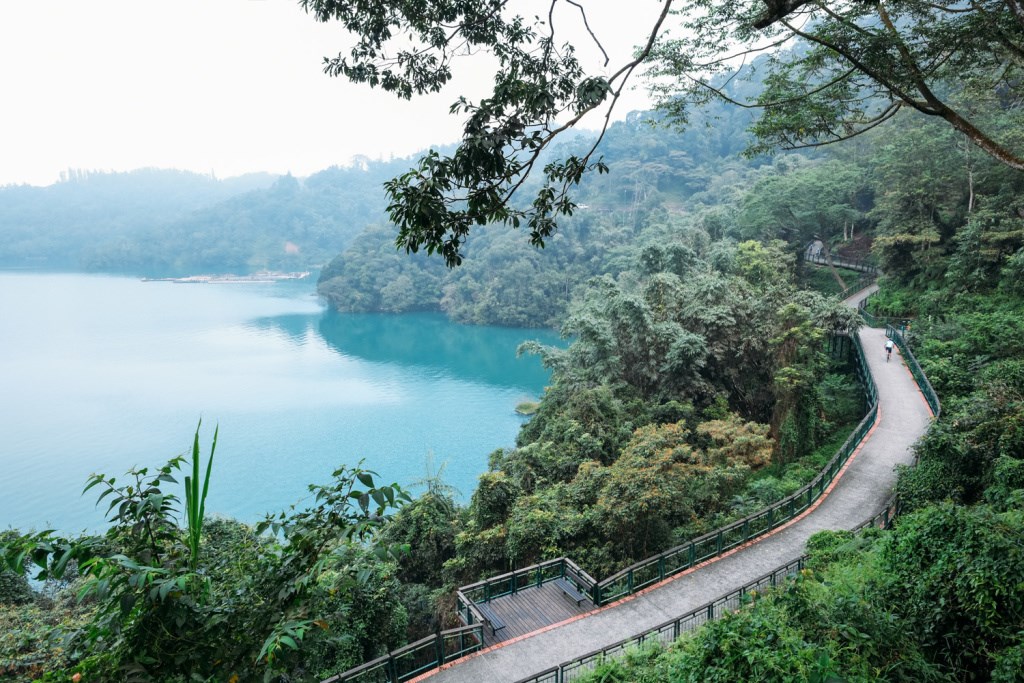
Sun Moon Lake Cycling Routes
World's Top 10 breathtaking cycling routes - Sun Moon Lake
Located in the heart of Taiwan, the Sun Moon Lake has long been charming curious foreigners and local visitors alike. The route around the largest lake in Taiwan is a three-hour ride, where visitors can enjoy lake scenery, experience Thao aboriginal culture and learn about the local ecology in the Nantou County. If you arrive in early spring, you can even catch the cherry blossoms near this mirror-like lake. -
Sun Moon Lake
100 Years of Well Known Beauty, The Must-Visit 8 Attractions in Taiwan
The Sun Moon Lake National Scenic Area covers five major recreation attractions - Huantan, Shuili River, Puli, Zhuoshui River and Jiji. Surrounding these major attractions are sightseeing hotspots such as Taomi, Checheng, Jiji, Shuishe Great Mountain, Shuanglong Waterfall, Mingtan Reservoir and Shuili River.
Sun Moon Lake’s beauty is created by mountain and water. Diffused misty clouds and distinct mountain views all evoke poetic and romantic scenes from Chinese landscape paintings. Therefore, this area is renowned as Taiwan’s famous “Eight Beautiful Scenic Attractions.” -
Taichung National Theater
The National Taichung Theater was designed by Japanese architect Ito Toyo. Based on the "sound cave" concept, elements such as curved-wall units and air holes are used to build this changed space. The result is a newfound building that stands on its own firmly without supporting pillars or 90-degree walls at all.
The theater is equipped with three professional performing venues which meet international standards: Grand Theatre, Playhouse and Black Box. They can each be adapted to fit the needs of various types of productions. There is also a multi-functional space, "Corner Salon," where educational events and public speeches may be held. The green Outdoor Plaza and the rooftop Sky Garden are great for the public to spend some leisurely hours in.
The architecture of the National Taichung Theater is a work of art. The theater's performing venues and garden are unique, too. It is worth paying a visit here for an artistic feast, from the inside out!
-
v
v
v
-
4-star or 5-Star Hotel in Taichung
Breakfast at Hotel
Check out and transfer for 1 Day Tour / Departure
Morning: Bubble Tea DIY in Chunshuitang Tea House
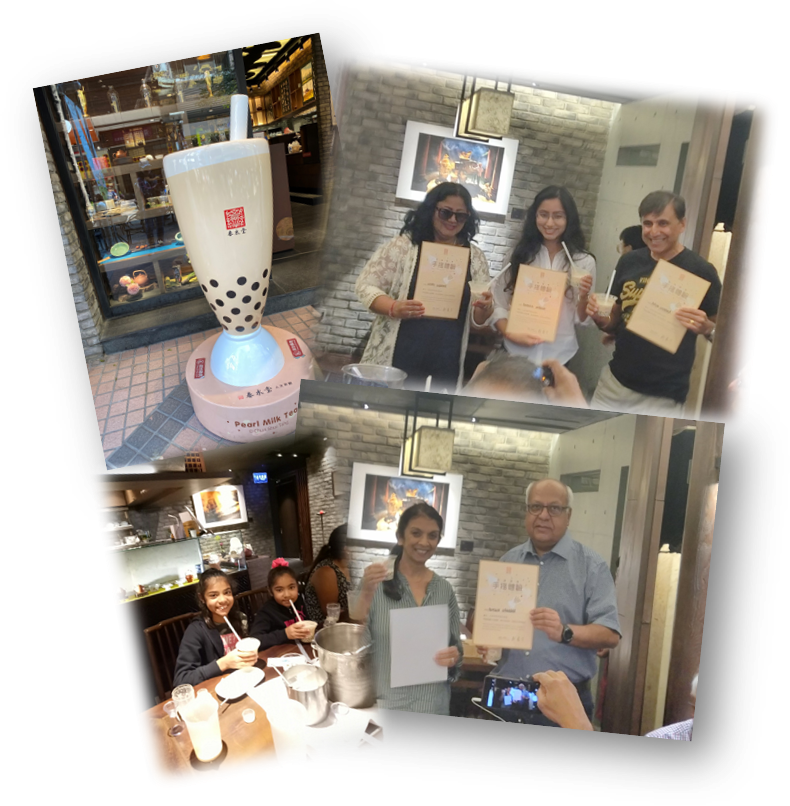
Afternoon: Daxi Old Street / Taoyuan International Airport for departure
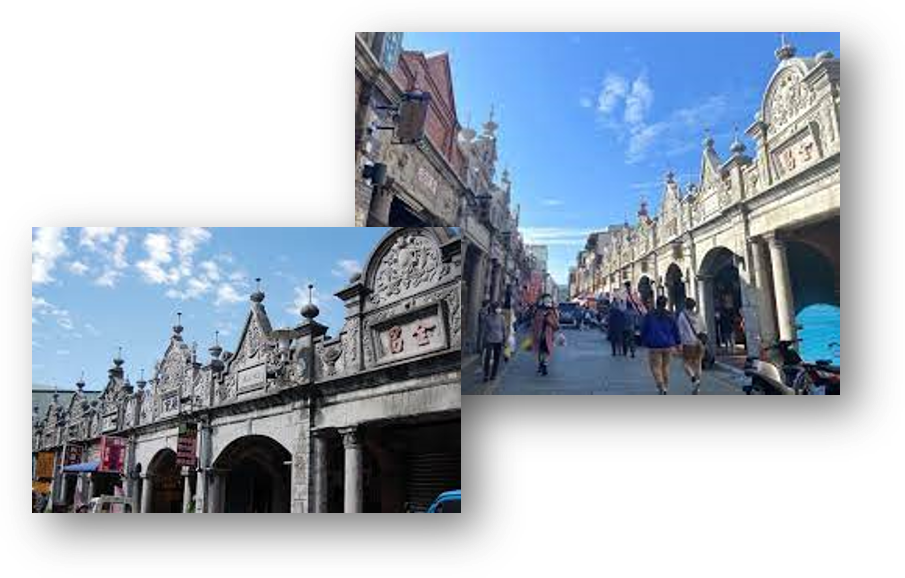
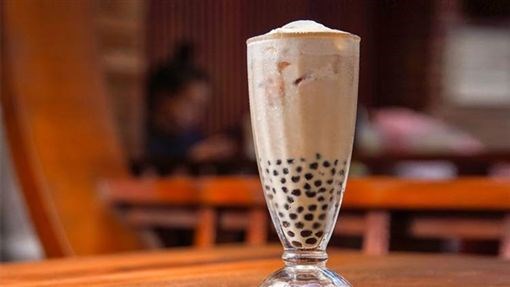
Pearl Milke Bubble Tea
Invented in the 1980s, bubble tea (also called “black pearl tea” or “boba tea”) is a beloved Taiwan classic. Though there are dozens of different variations, at its core it’s a combination of tea, milk and the ‘bubbles’ – which are essentially little balls made of anything from tapioca to fruit jelly.
Daxi Old Street, Taoyuan
Daxi was the earliest developed area in Taoyuan. Thanks to small sailboats sailing between Dahan Creek and Tamsui River, Daxi had a thriving trade with China, and its prosperity brought success to many stores and businessmen. During the Japanese occupation period of the Taisho era, Baroque architecture was the popular building style and therefore many stores along Heping Road and Zhongshan Road were built in the Baroque style, but decorated with both Baroque ornamentation and characteristic totems of Min-nan in Southern China. On the facade of some old houses, auspicious Chinese fish and bat totems appear on Greek lintels or Roman columns, constituting a unique feature of Daxi. Because Heping Old Street was developed relatively later, the buildings in this area are better preserved. Specialty shops and food stands on the street always attract many tourists.
Other scenic attractions in the area include Daxi Bridge, Lee Teng-Fang Ancient Residence, Wude Temple, Daxi Wood Art Ecomuseum, etc. Daxi Old Street provides not only traditional Taiwanese toys, but also authentic must-try Taiwanese delicacies, including Daxi dried tofu, moonlight cakes, peanut caramel candies, tofu puddings, salty rice puddings and rice dumplings. When traveling in Taoyuan, be sure to visit Daxi Old Street, where you will experience the true Taiwanese flavor!
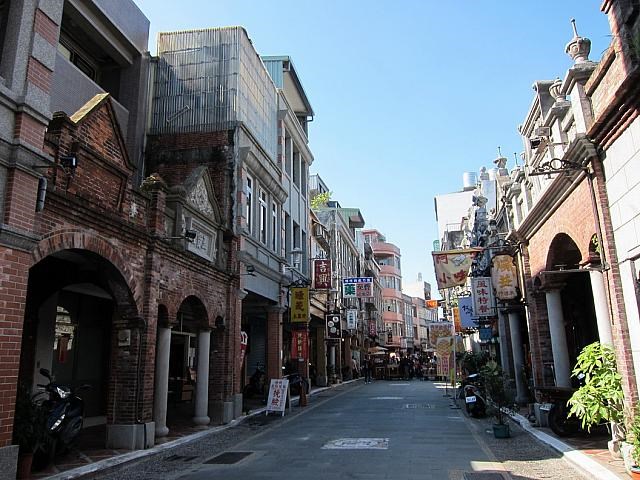
-
v
v
v
-
-

